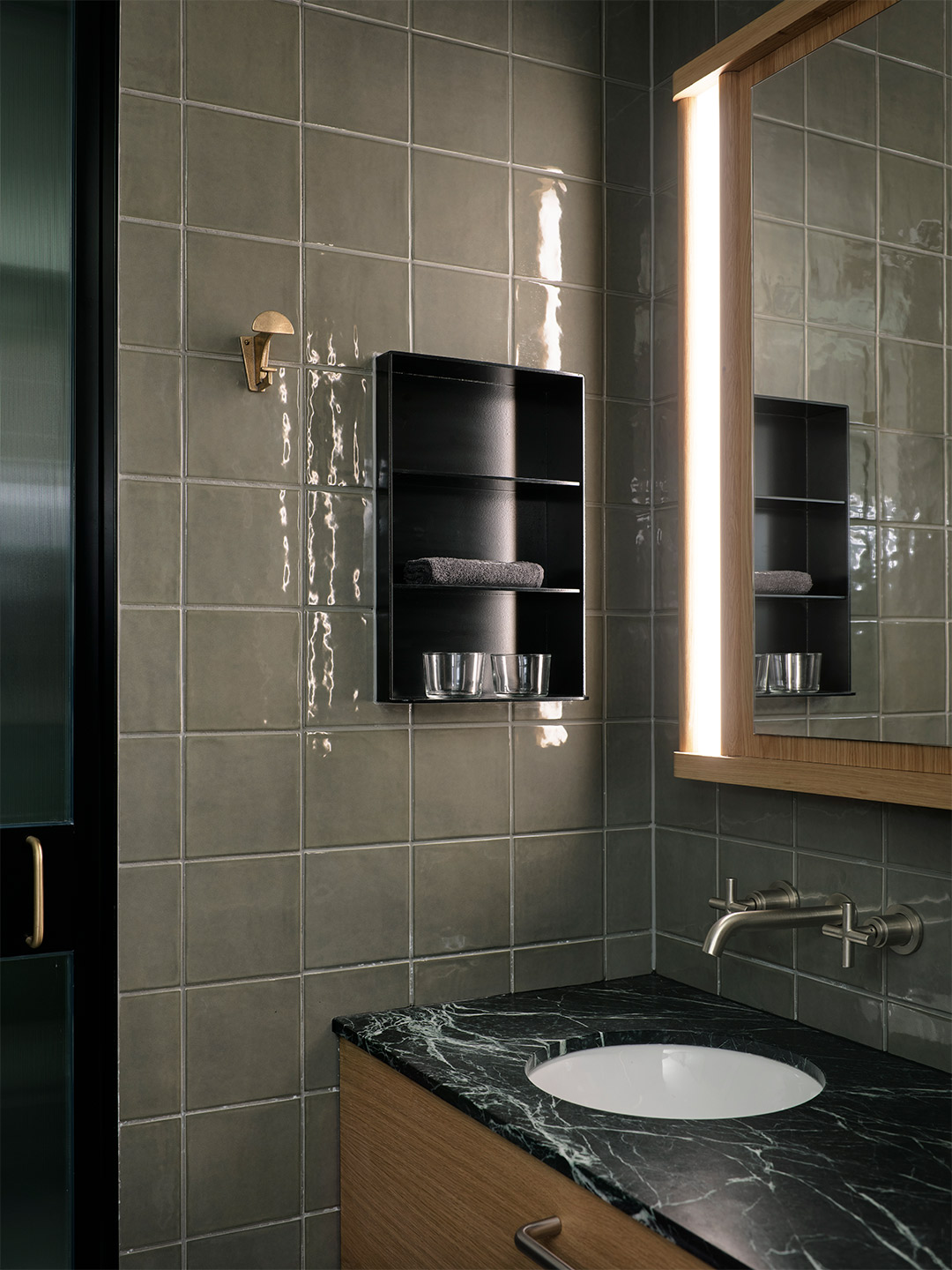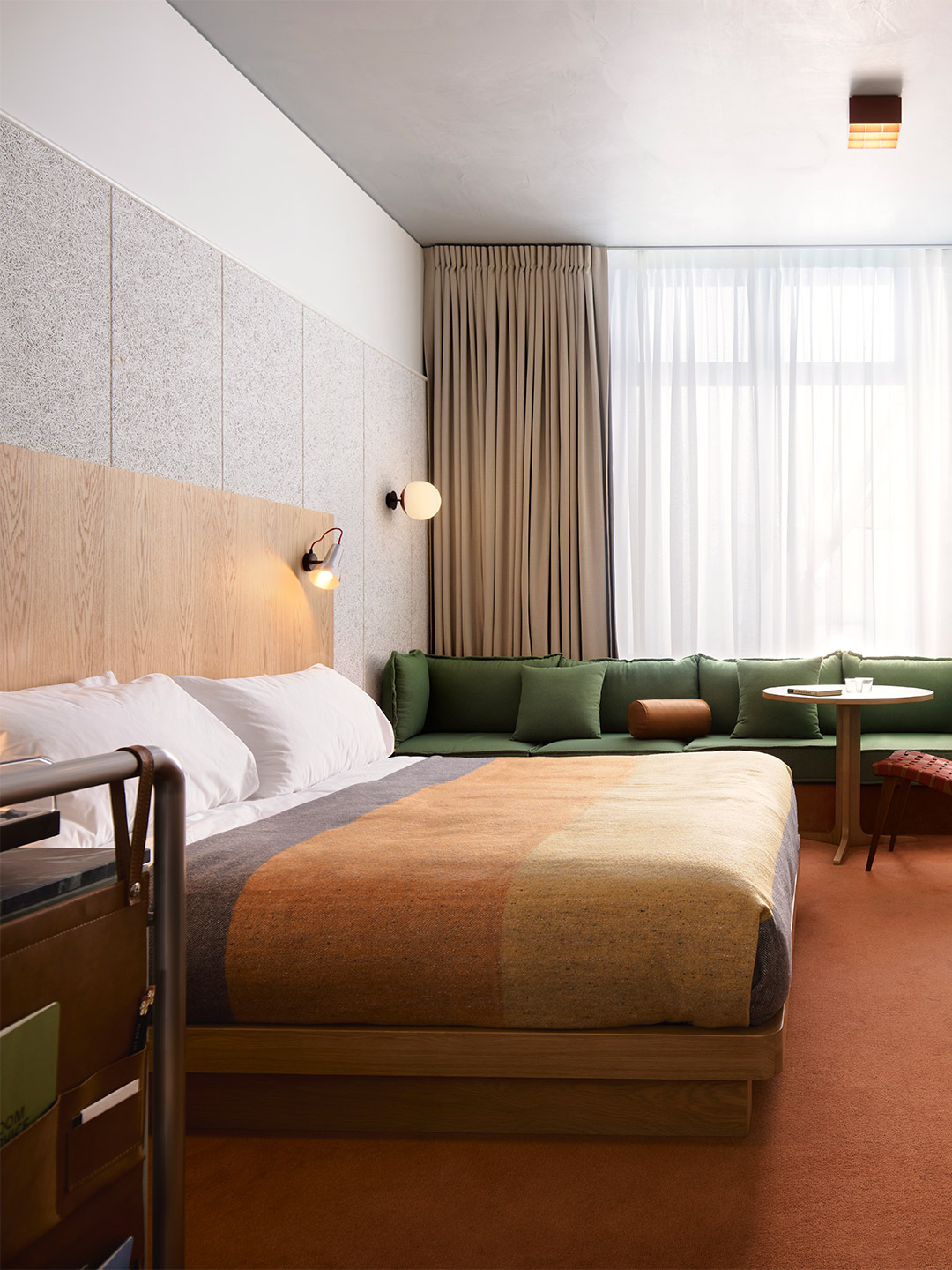Sydney has a new contemporary art gallery. Well, not officially. But with the amount of all-Australian works procured and placed (or painted directly onto the surfaces) throughout the pensive 257-room Ace Hotel – it could easily be mistaken for just that. Located in Surry Hills, in the storied Tyne factory building, the first phase of the David Flack-designed hotel is now open to the public. With three of four drink-and-dine establishments also designed by David and his team at Melbourne-based Flack Studio (KILN by Fiona Lynch Office will open later in the year) there are even more reasons to visit this hip hotel besides simply checking in and bunking the night.
Inspired by the visionary modernist architect Robin Boyd and his 1960s book, The Australian Ugliness, Ace Hotel Sydney tells its story with a palette reflective of the hard-working history of its industrial shell. The use of raw, tactile and moody materials, exampled by off-form concrete walls, locally sourced timber and aged brass, nods to the surrounding neighbourhood. But at the same time, these finishes honour the history-rich site, resulting in a series of comfortable and communal spaces for everyone – not just guests clutching a room key – to enjoy.
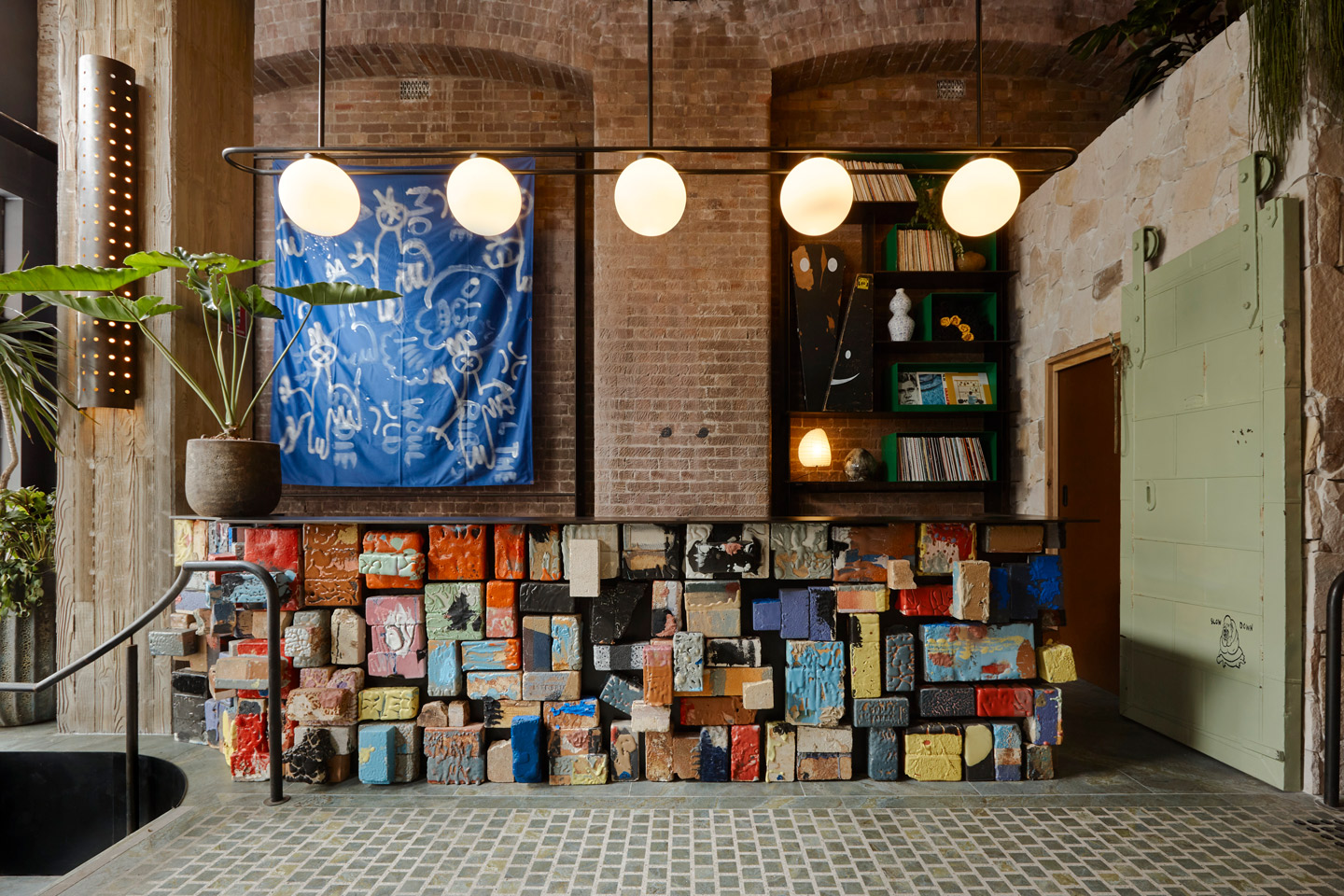
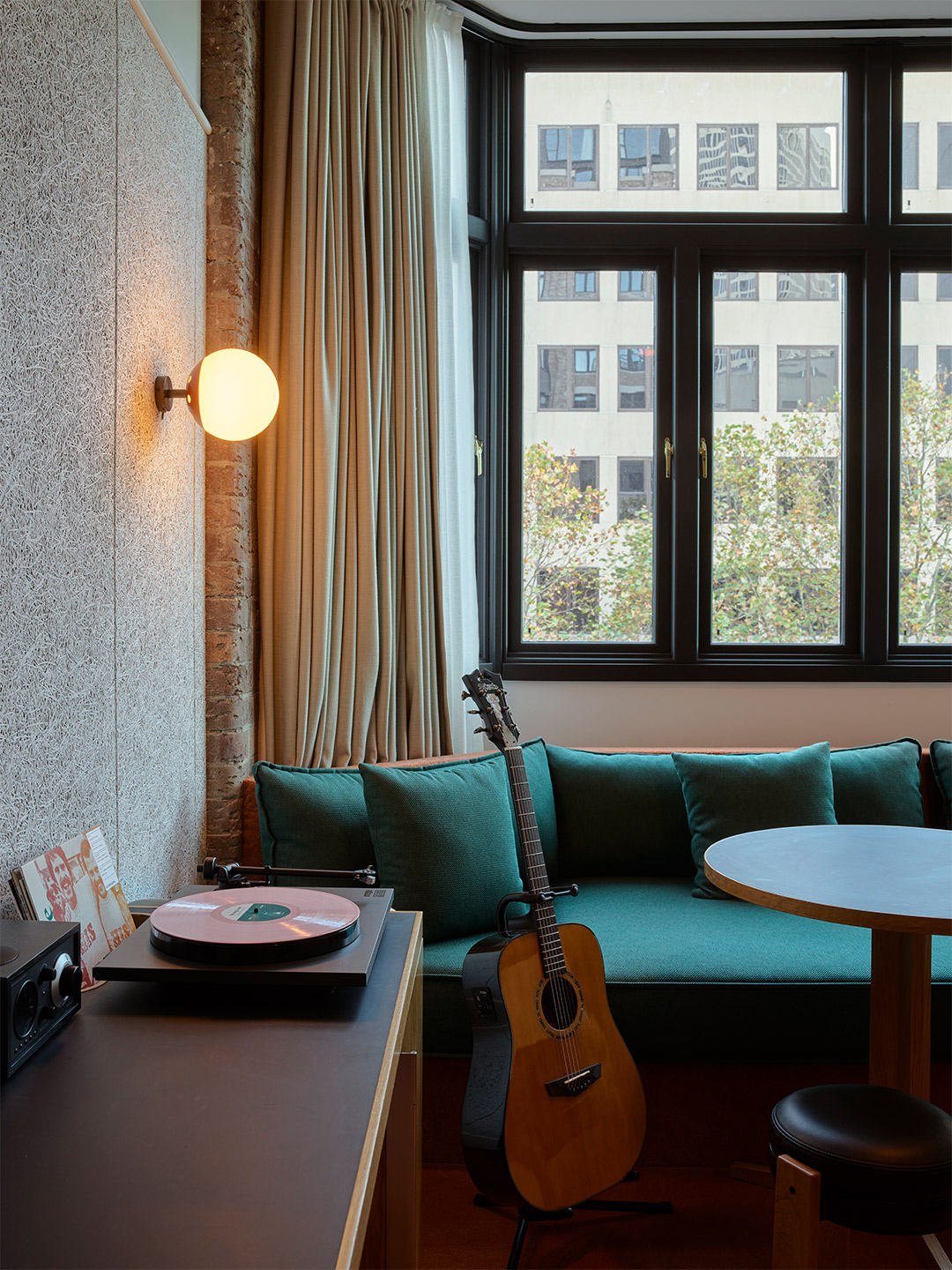
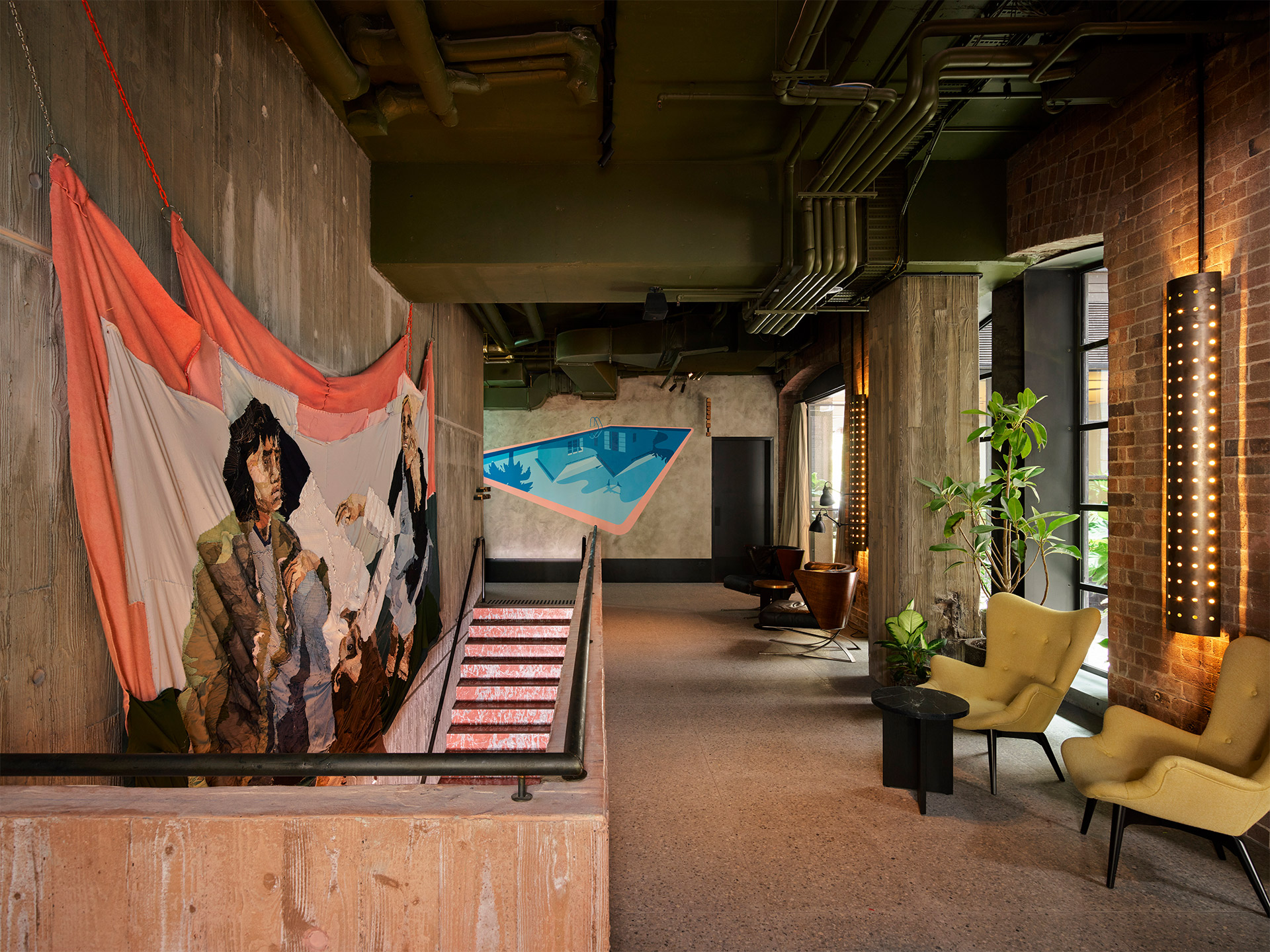
Artful lodger: Inside the Ace Hotel Sydney by Flack Studio
The materiality throughout the hotel’s interior speaks to Sydney’s broader natural landscape and its resources: glowing terracotta tiles make an appearance in the guest rooms, local sandstone features on the wall of the ground floor and a delicious red marble staircase leads from the ground floor to the first level. Applied in inventive ways, typically classic materials – think oak, brick, leather, raw concrete, steel and marble – then adopt the important role of merging the historic with the cutting-edge inside the building’s four patinated walls.
Ace Hotel Sydney’s main entrance is on Wentworth Avenue, a thoroughfare connecting the city’s central railway station to the CBD. It’s upon entering from Wentworth Avenue that guests encounter the first striking art installation: the hotel’s reception desk, a commissioned piece by ceramicist James Lemon. Made up of polychromatic glazed brick in recognition of the site’s industrial past, the desk becomes a beacon representing the building’s dynamic new life. Framing the reception desk are works by Sydney-based artist Nell, a favourite of Flack’s, whose pop culture-referencing work is on display with Two Sounds (2011). There’s also a large wall-hung work by multidisciplinary artist Jason Phu, who uses references from traditional ink painting and calligraphy in if the moon farted all the birds would die (2021).
Opposite the front desk sits the hotel’s retail collection; a curation of apparel and gifts designed by the in-house creative team at Atelier Ace. But this is no run-of-the-mill giftshop. Also featured in the ever-rotating offering is a selection of items found inside the guest rooms – a sign of things to come in the upper levels. These shoppable wares include the custom-designed Rega record players and Tivoli radios, Byron-sourced Deiji Studios robes with insignias by artist Jason Phu, Studio Henry Wilson-designed brass wall hooks, a Flack Studio-designed stool, and an Ace signature item: a custom-created blanket, made in collaboration with New Zealand wool-weavers Stansborough and Flack Studio, featuring colours inspired by the landscape paintings of Indigenous Australian artist Albert Namatjira.
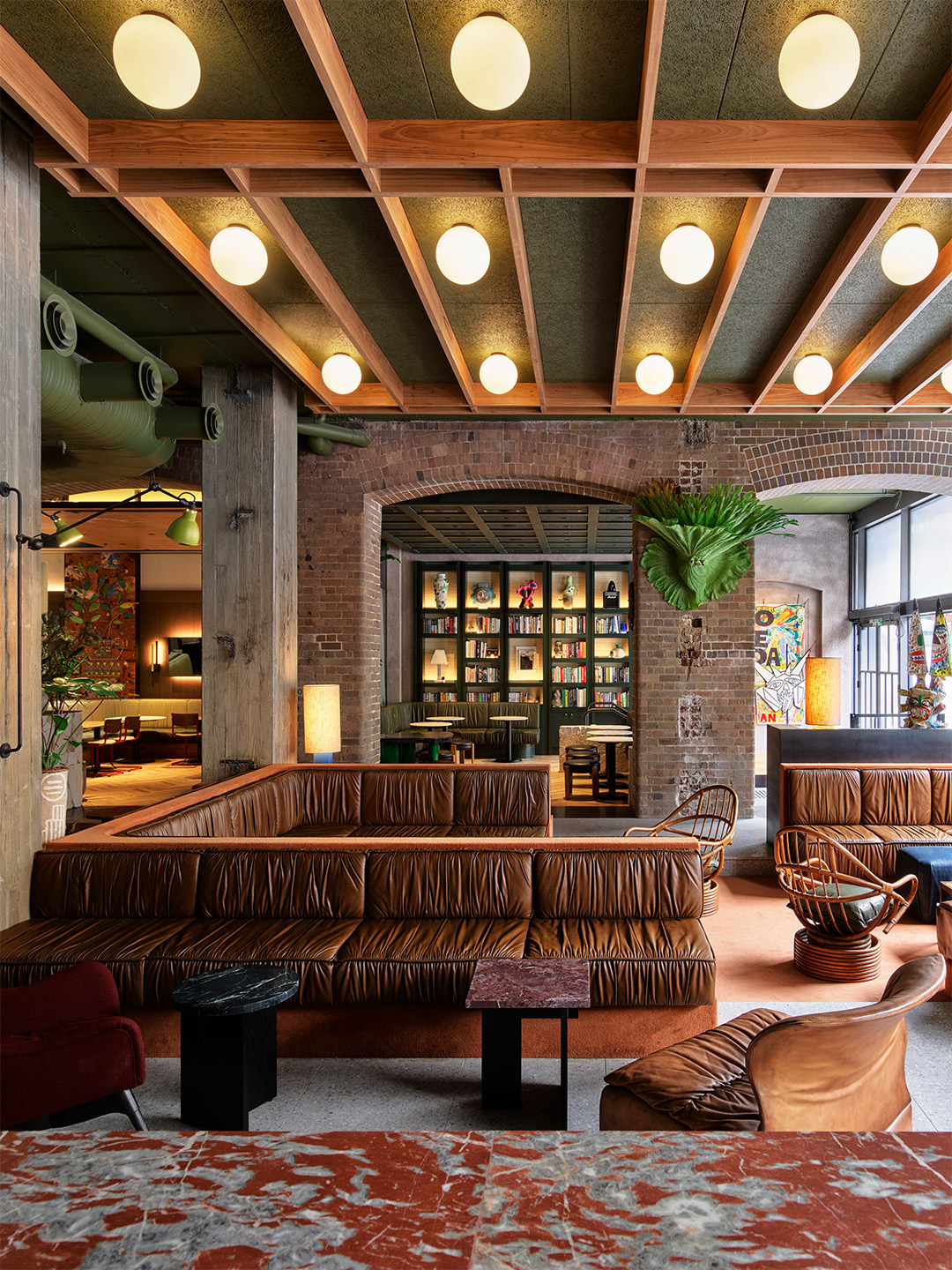
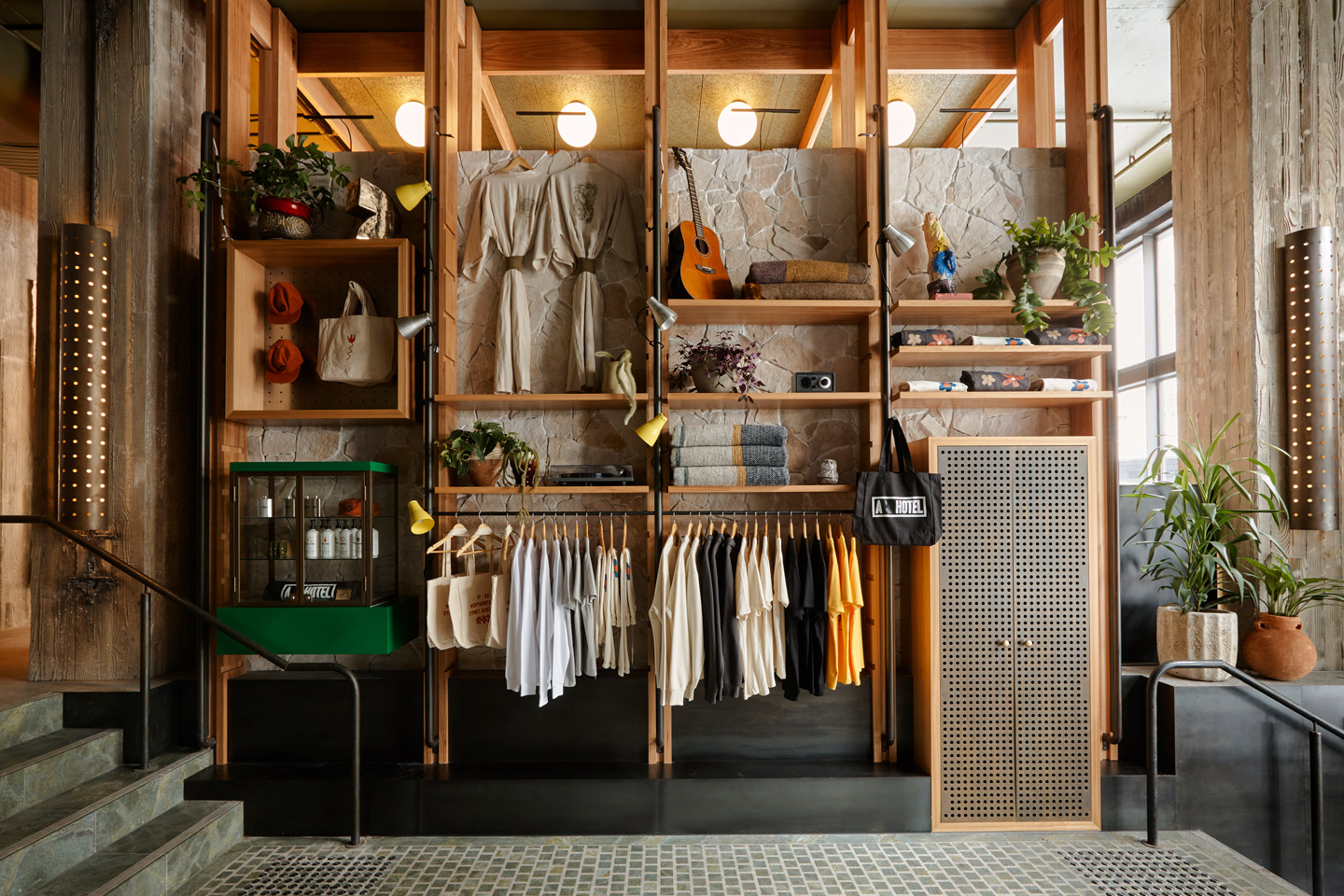
Looking in the direction of the main entry, floor-to-ceiling windows peering onto bustling Wentworth Avenue illuminate The Lobby lounge – a common space open to the public, activated by music and art, and a hallmark of the Ace brand. The Lobby’s glass frontage delivers a bright, relaxed feel to the space, which is framed with sandstone walls and lush foliage. Reclaimed earth-toned brickwork, warm terracottas, tans and lush greenery are continued throughout the floor, continuing the efforts to bring to life the evocative colours of the Australian panorama.
The Lobby showcases a marble-topped bar, with stools created especially for the venue lining the service area. The sunken lounge, which rests in the centre of the room, offers a delightful wink to 1970s suburban Australia. Made from an ochre-orange carpet, with pleated tan leather cushions, it invites guests to sink into conversation – martini in-hand. The central lounge of The Lobby is echoed in the design of the guest rooms, with most of the rooms featuring an inviting nook in which visitors can recline or converse. A ceramic piece by out-of-the-box sculptor Ramesh Mario Nithiyendran – another of Flack’s go-tos – watches over the space.
Ascending from the ground floor, the deep ochre-red marble staircase delivers hotel guests to the level-one event quarters. Three event spaces are available on this floor and can be combined to suit any occasion. Framing the staircase to the left is Julia Gutman’s large-scale tapestry, Once More, with Feeling, made from clothing previously owned by the artist and her friends. Upon reaching the level-one landing, guests are greeted with a commissioned painting by the Perth-based artist Joanna Lamb – one from her ongoing series of paintings depicting suburban swimming pools.
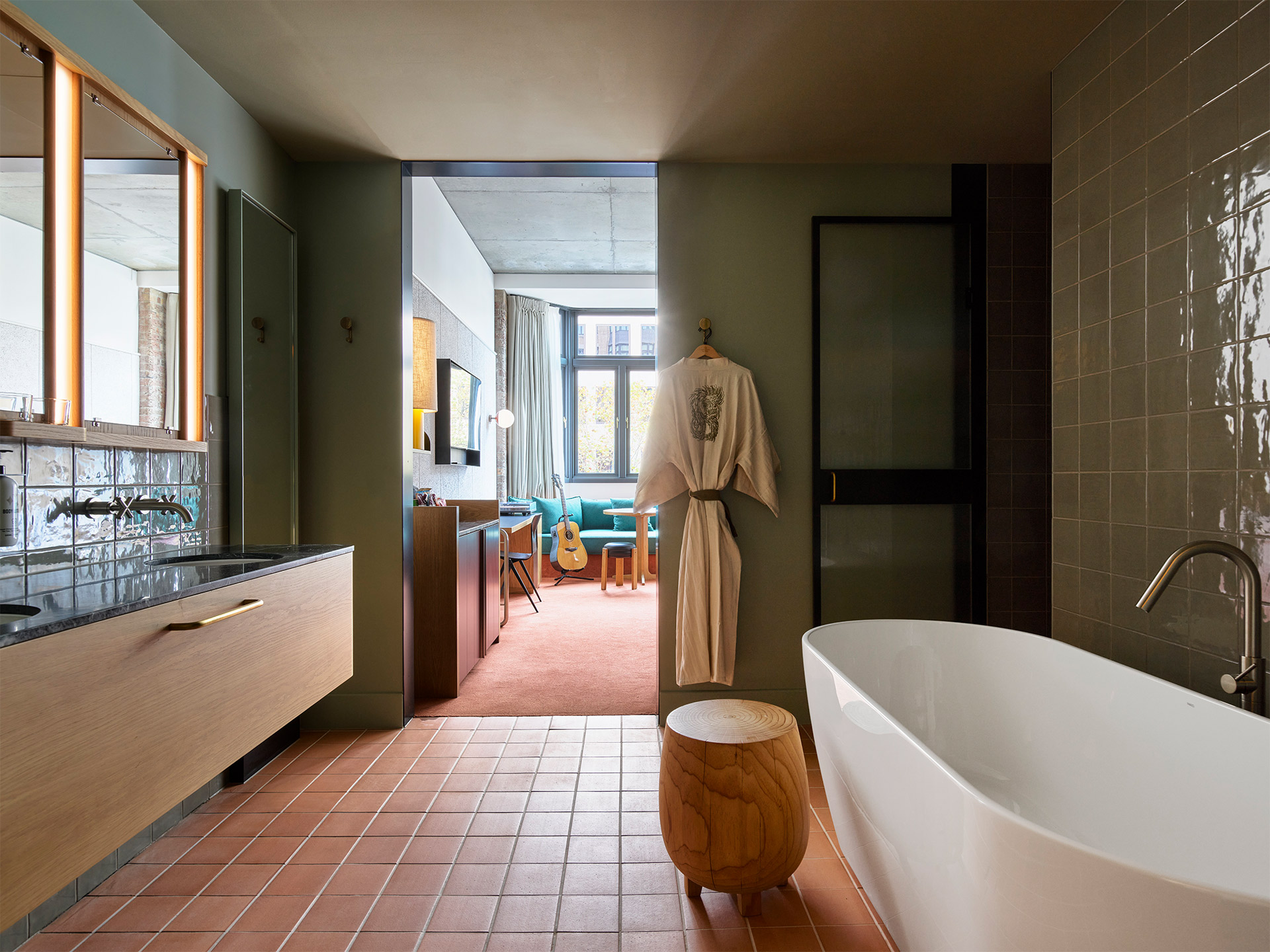
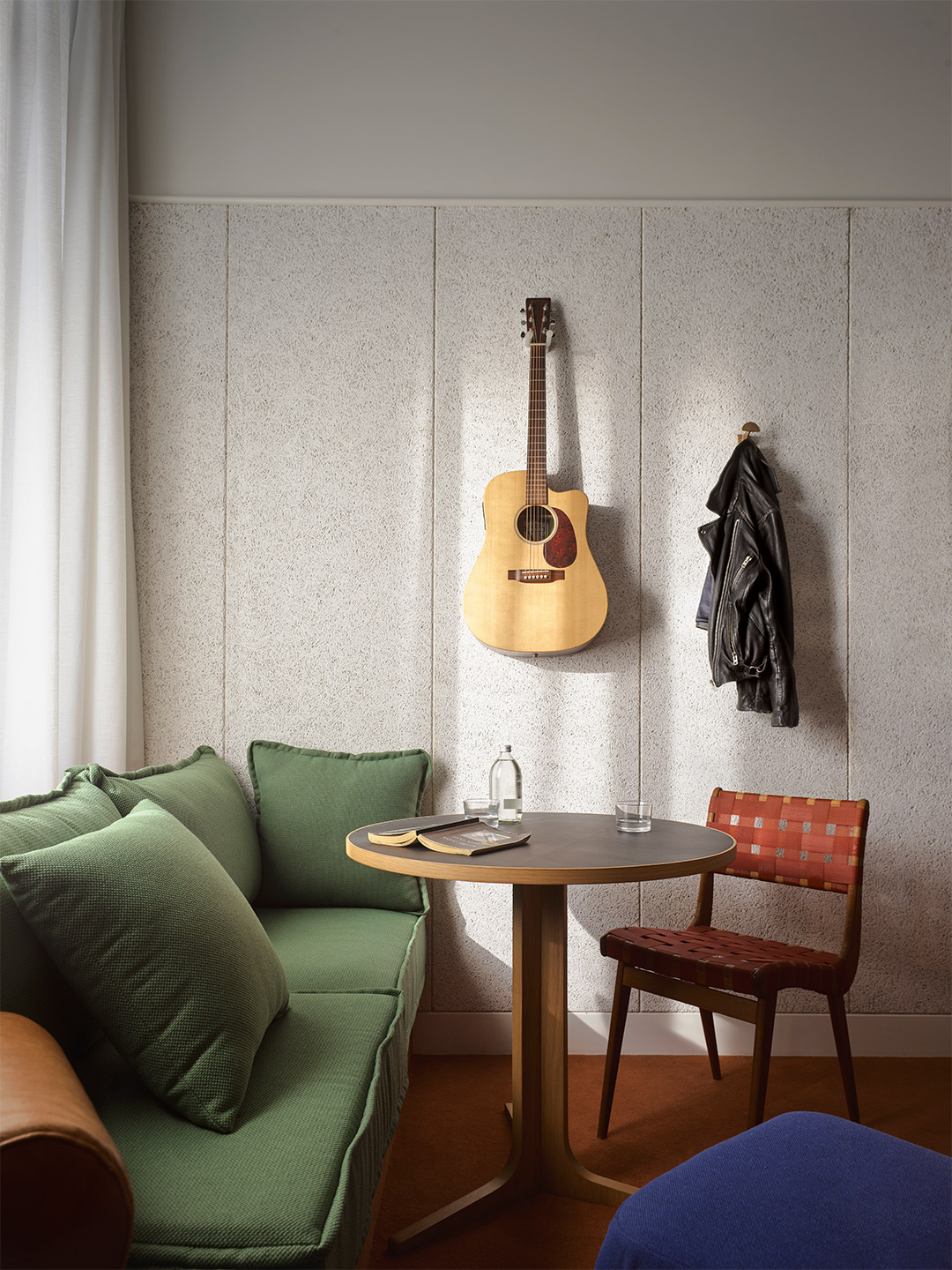
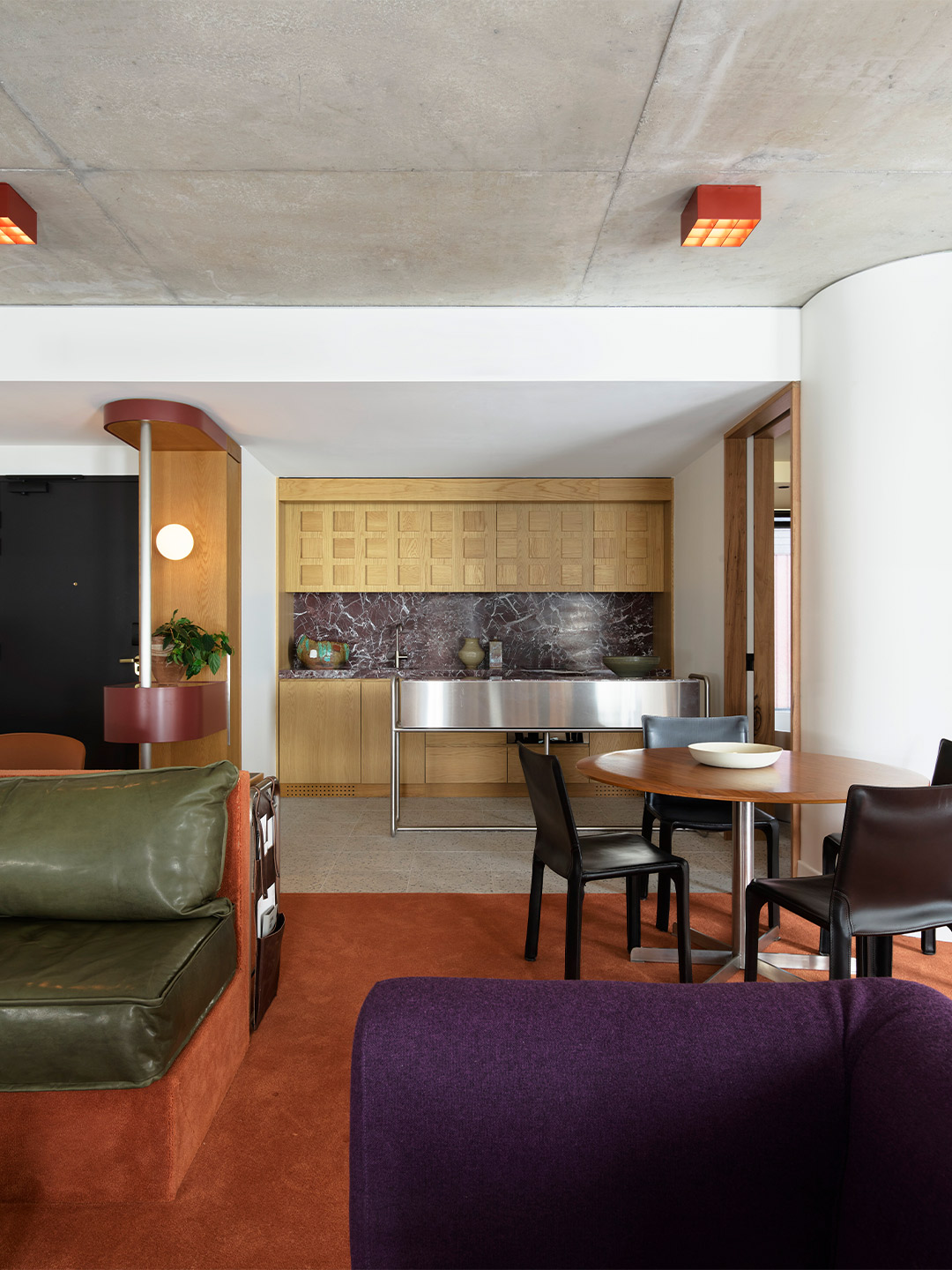
Almost all of the furniture and lighting in the hotel is custom-designed by Flack Studio and their collaborators – from the banquette seating in LOAM (sister restaurant to LOAM in Downtown Los Angeles), to the stellar sconces placed throughout the ground floor. Woven in-between the custom works by Flack are iconic modernist designs: lighting by Isamu Noguchi, the Tobia Scarpa “Nuvola” lamp and select vintage chairs scattered throughout the hotel’s interior. In keeping with the building’s design, the materials used by Flack are raw yet refined, with a modern edge: armchairs and stools of oak, accents of green velvet or black leather, marble tabletops and linen lamp shades.
In designing the guest rooms, Flack Studio followed the modernist principle “that everything should have its proper home,” says the team from Atelier Ace. Thus, each detail was carefully considered: from the colour palette of warm ochres, terracottas and sunset orange, designed to envelop guests and offer a counterpoint to the urban environment outside; to the custom-built furniture and joinery, made to nestle into the idiosyncrasies of the heritage building with ease. Then there’s the custom-designed leather accessories in each room, made to house the minibar and amenities, as well as create handy nooks for travellers to store their sundries.
The first 10 floors of the hotel belong to the original building, while eight additional floors have been added above (with architecture by Bates Smart). The custom joinery and furniture give the rooms a residential feel. But the nuances between the old building and the new addition mean rooms are unique in detail and character. In the heritage rooms on the lower levels of the hotel, exposed brickwork is seen, while the newer levels display terrazzo flooring. Some of the rooms have open-air terrace balconies – a result of the vertical tower addition – then others feature charming bay windows overlooking Wentworth Avenue to the east, or oversized steel and glass factory windows facing Foy Lane to the west.
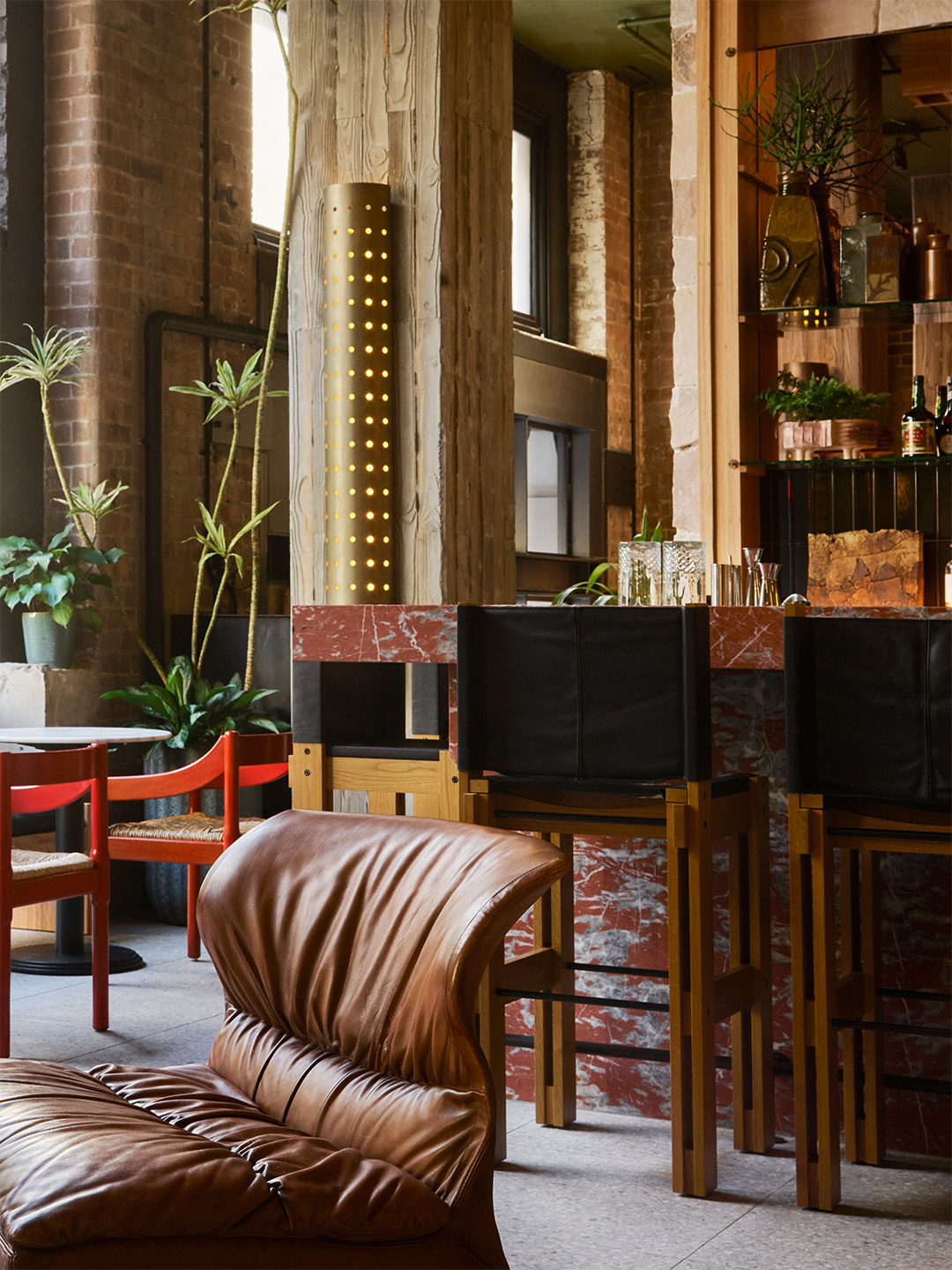
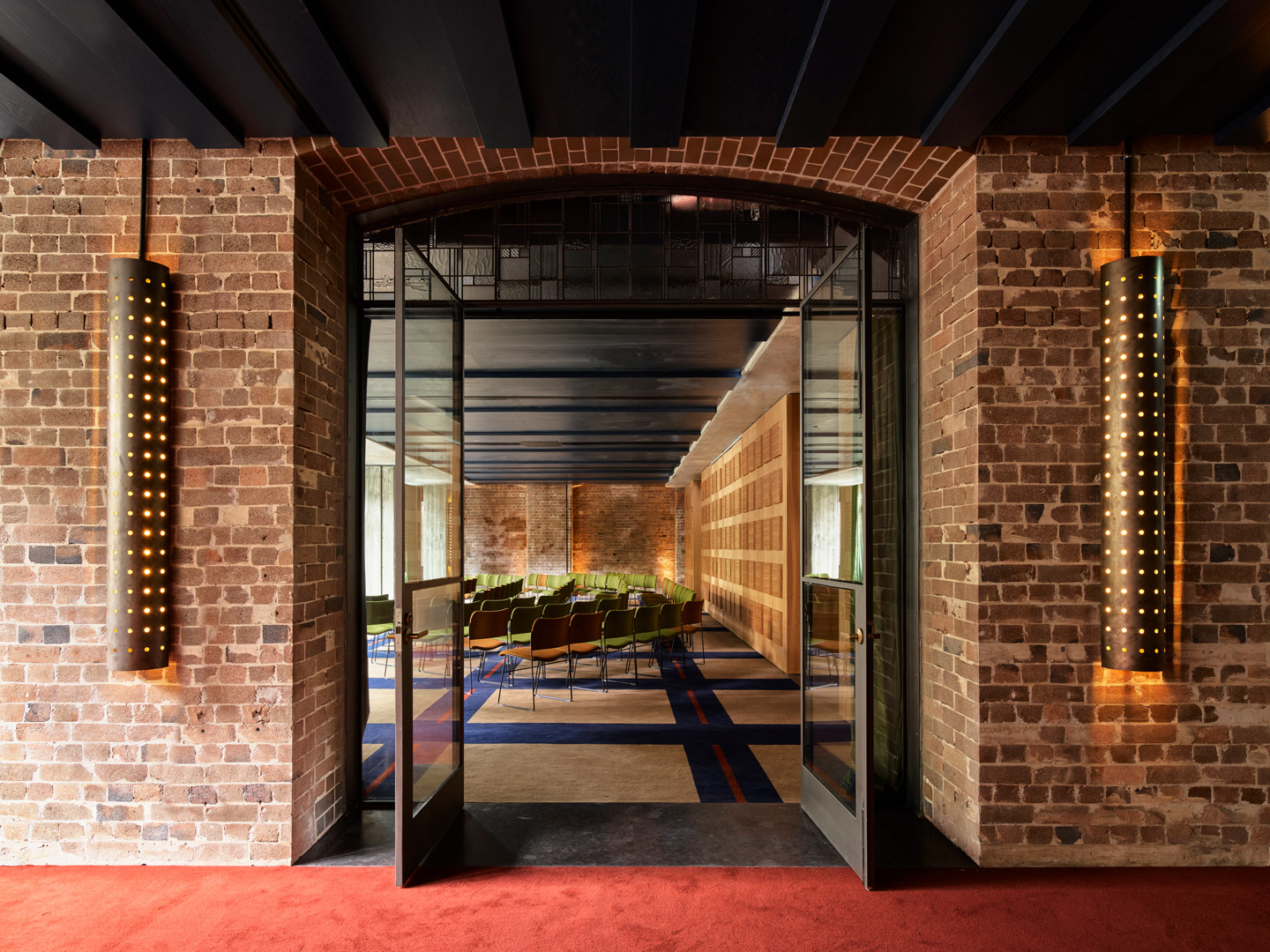
Returning to the hotel’s agenda-setting art program – perhaps Ace Sydney’s most memorable feature – Flack Studio curated an excitingly diverse selection of Australian artists’ works to display throughout the building. Beginning from the front desk, the artists in the collection are at the forefront of contemporary Australian art; a group that shares Ace’s playful creativity in their approach. One highlight includes the unexpected discovery of the ceramic library, inspired by the building’s former life as a ceramic kiln. Here, works by Nabilah Nordin, Scott Duncan, Ben Mazey, Laith McGregor, Kenya Peterson and others come together to time-capsule a moment in Australian ceramic history.
Tony Albert, a First Nations artist whose work incorporates what he calls “Aboriginalia” (kitsch objects adorned with stereotypes of Indigenous Australians) is another must-see, featured on the ground floor with a series of collaborative pieces titled Mid Century Modern. Then there’s Jason Phu’s work, which can be spotted in multiple locations throughout the hotel – his commissioned ink drawings appearing in corridors on various levels, on surfaces amid passageways and even inside the guest rooms, offering up a find-them-all challenge for the young or young-at-heart.
acehotel.com; flackstudio.com.au
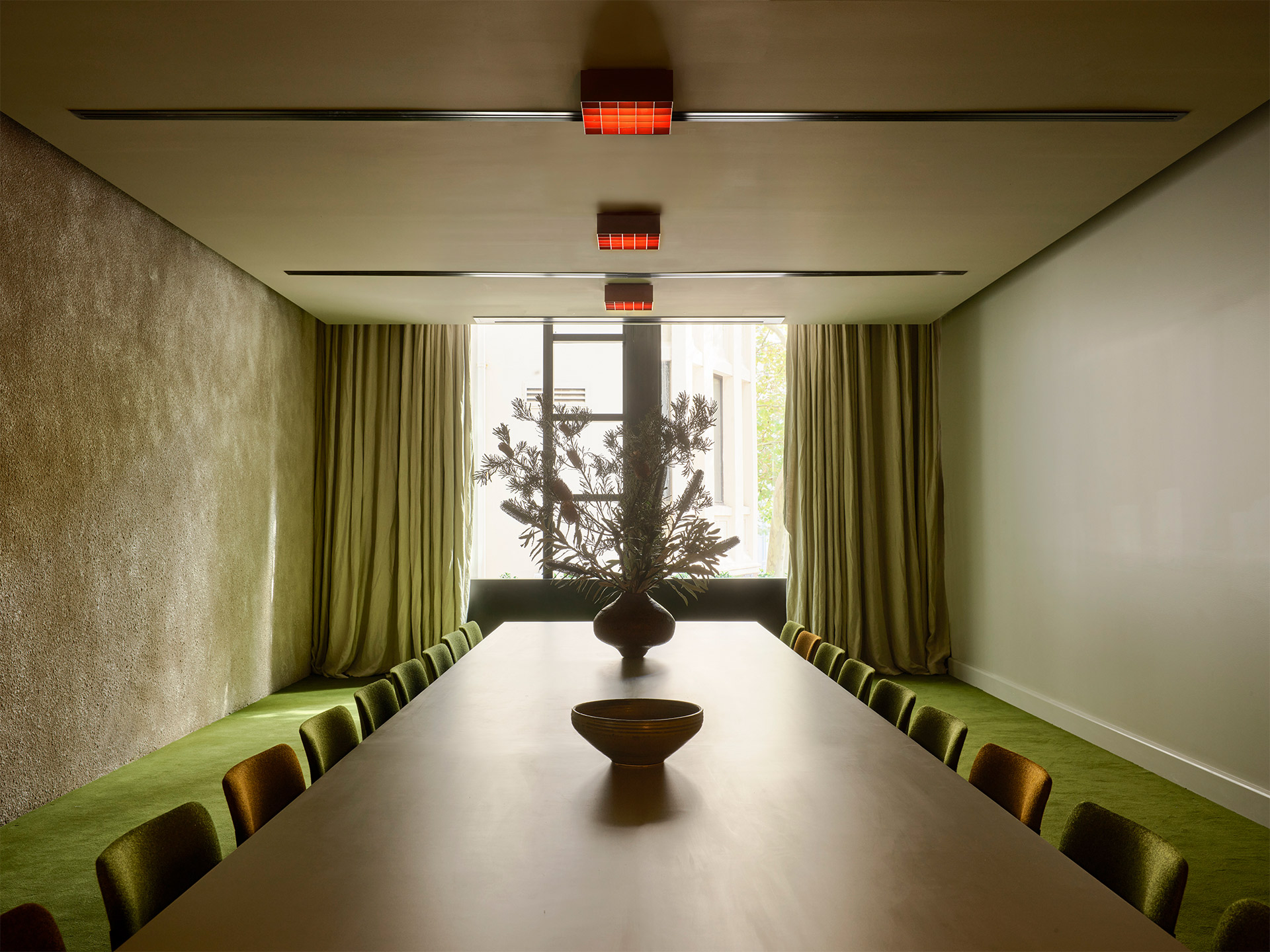
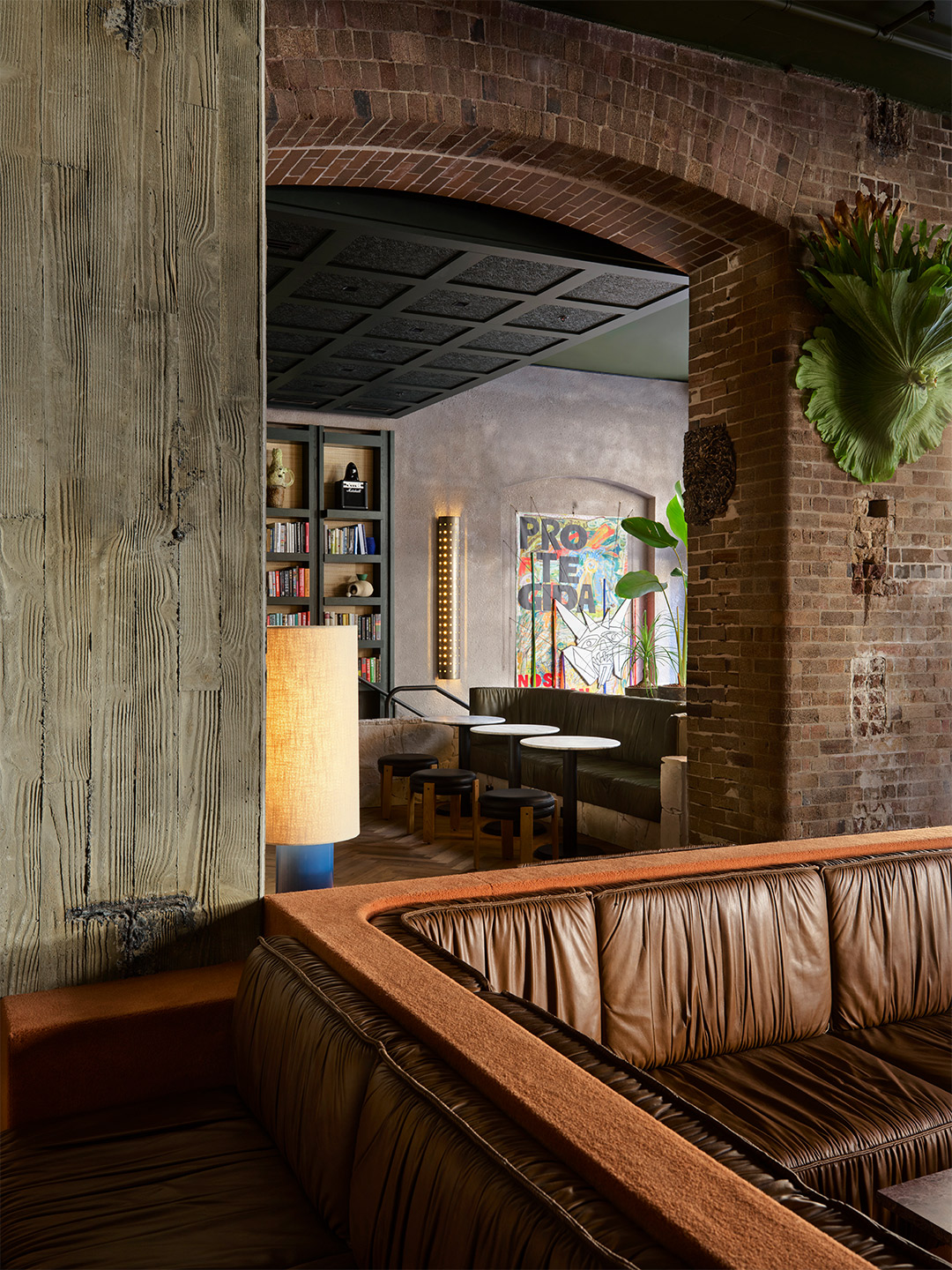
Surry Hills has been home to so many culturally important movements and people, and has always been a home for creatives and migrating cultures.

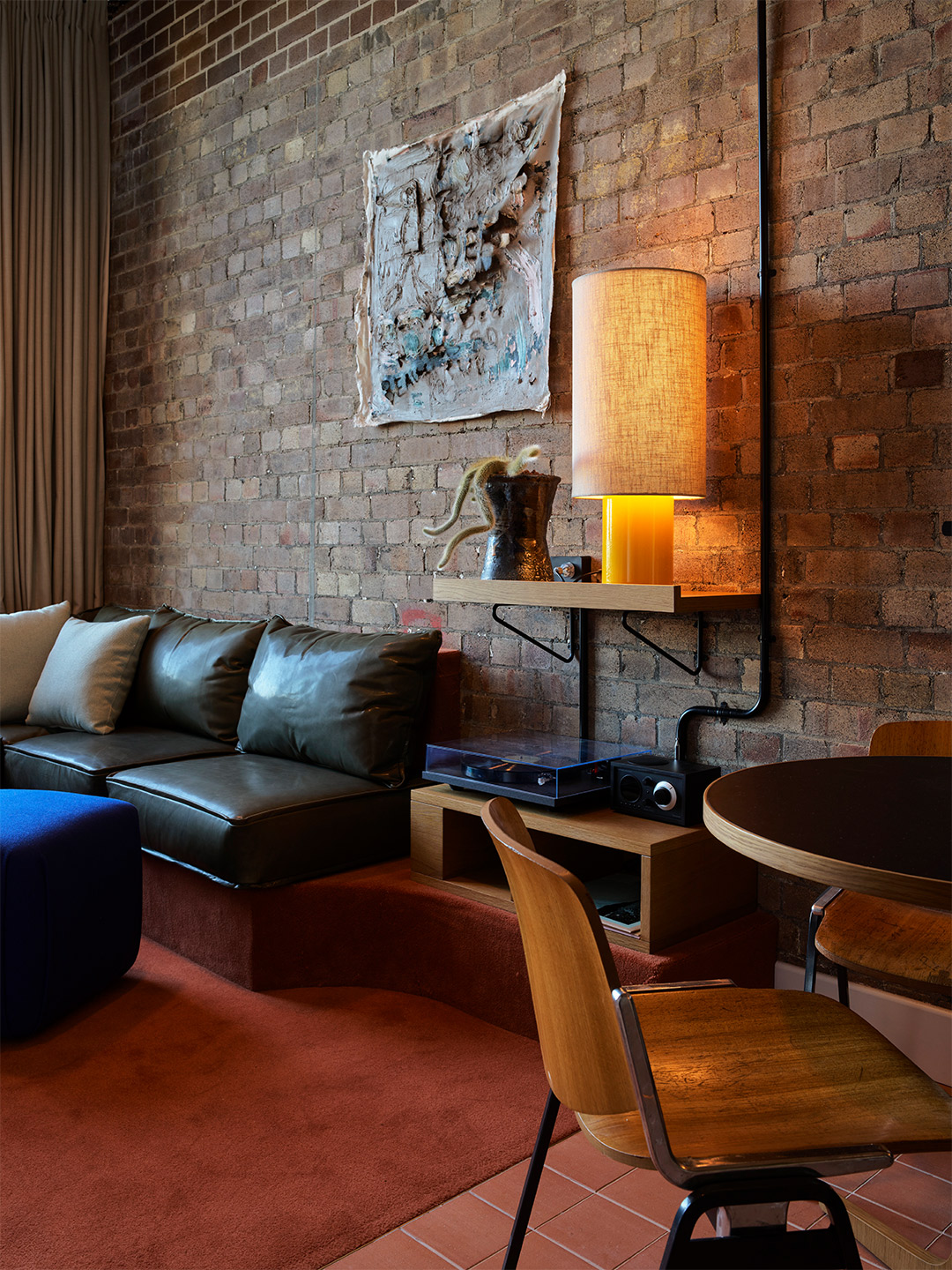
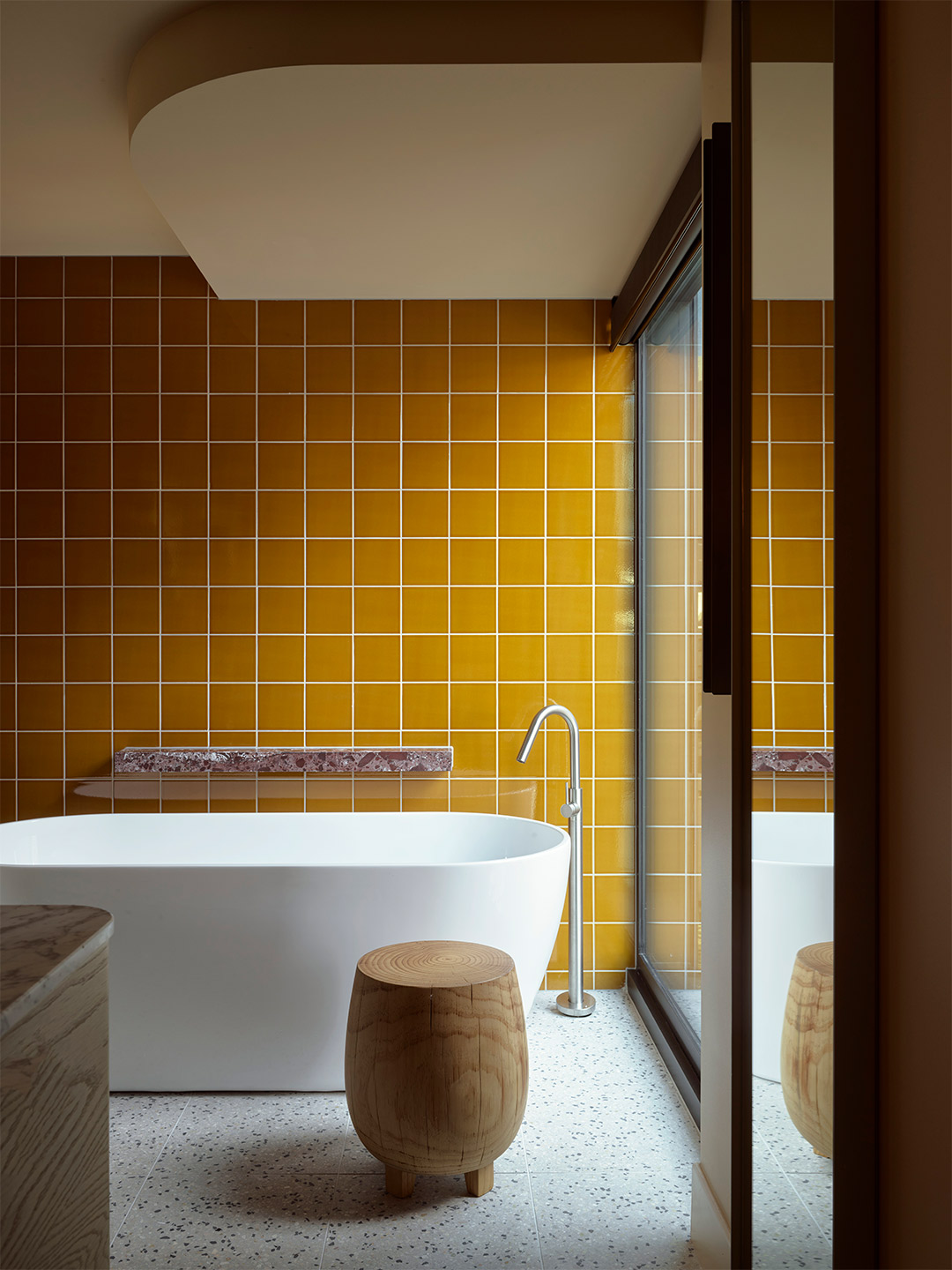
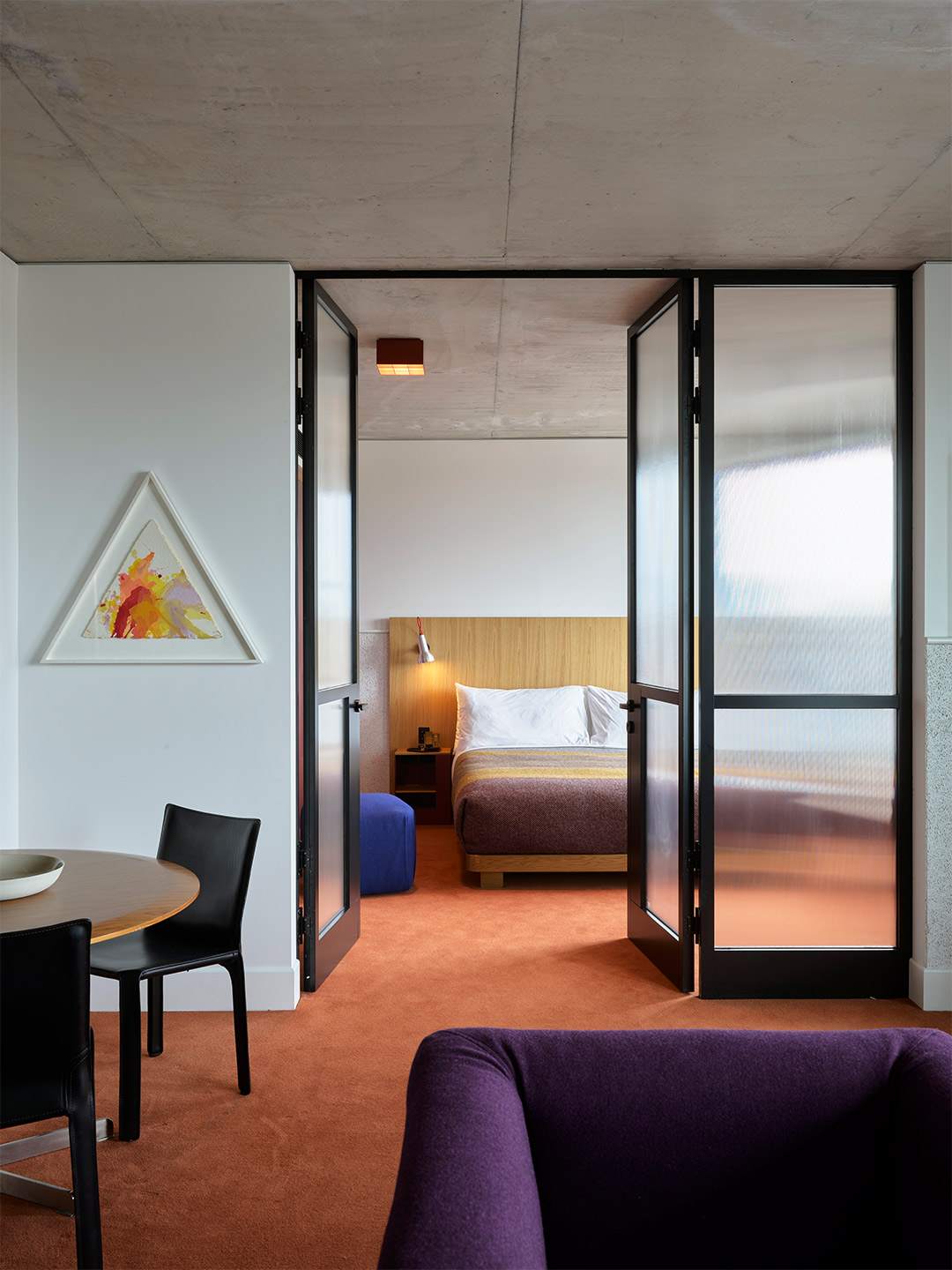
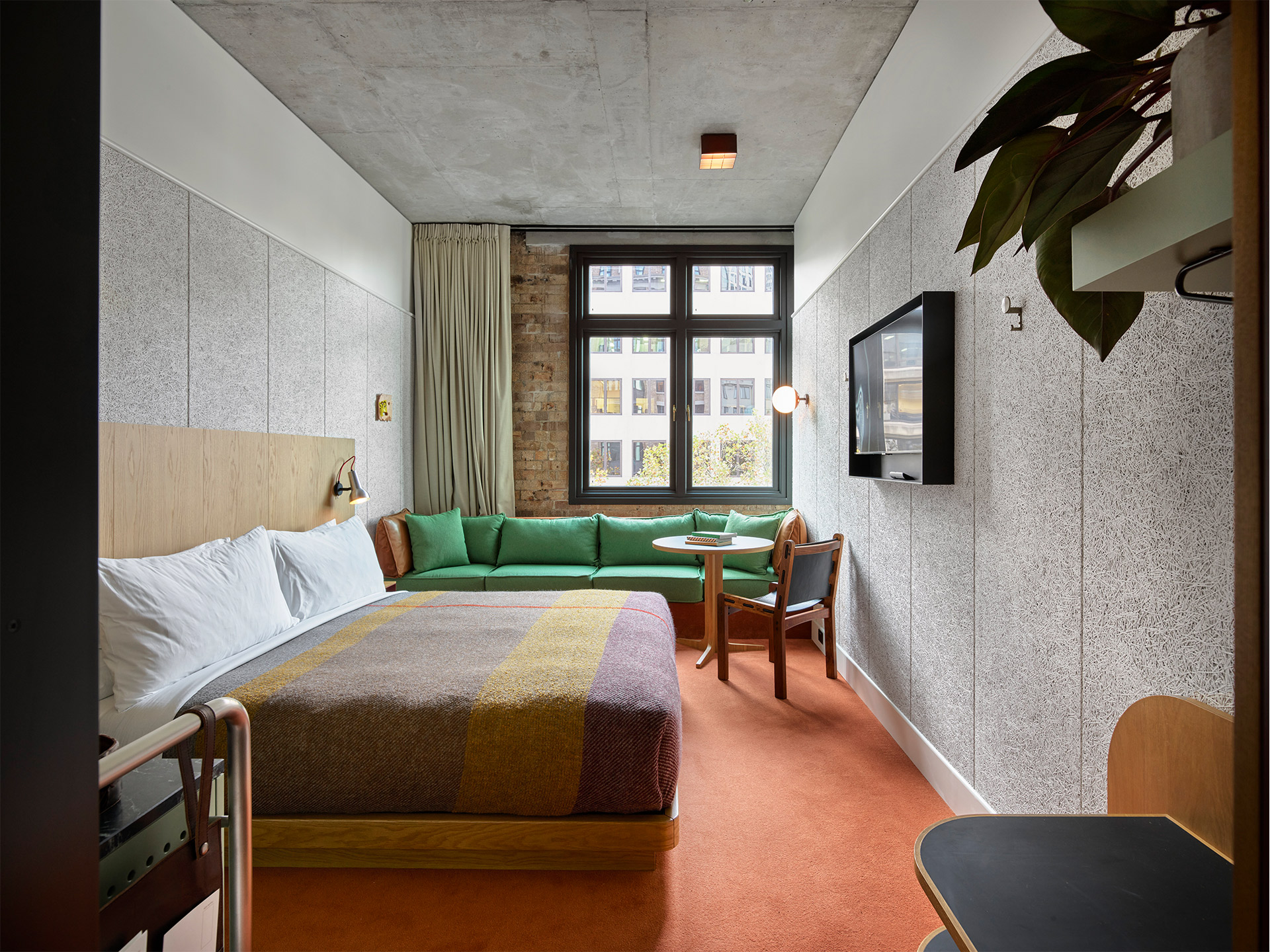
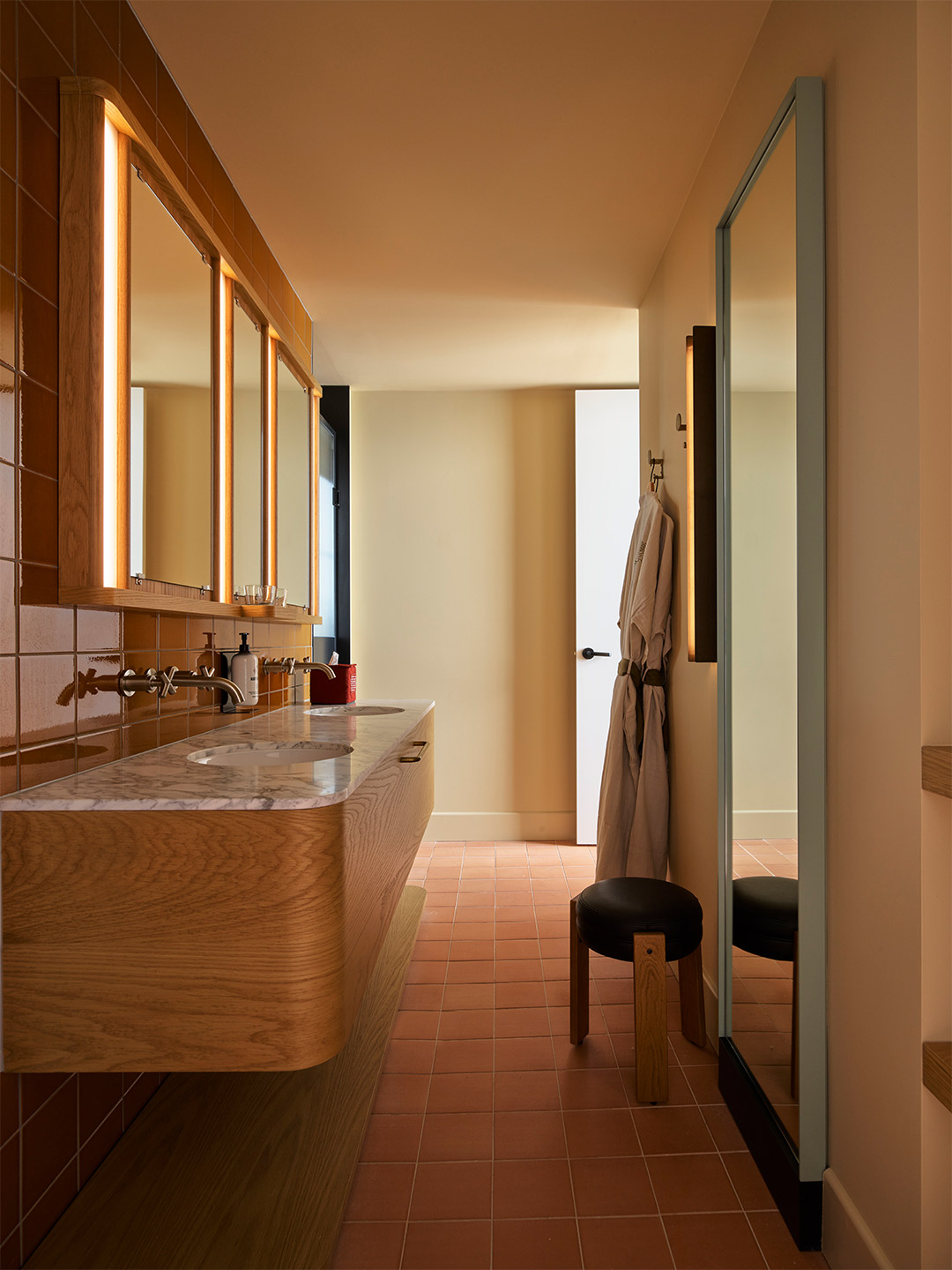
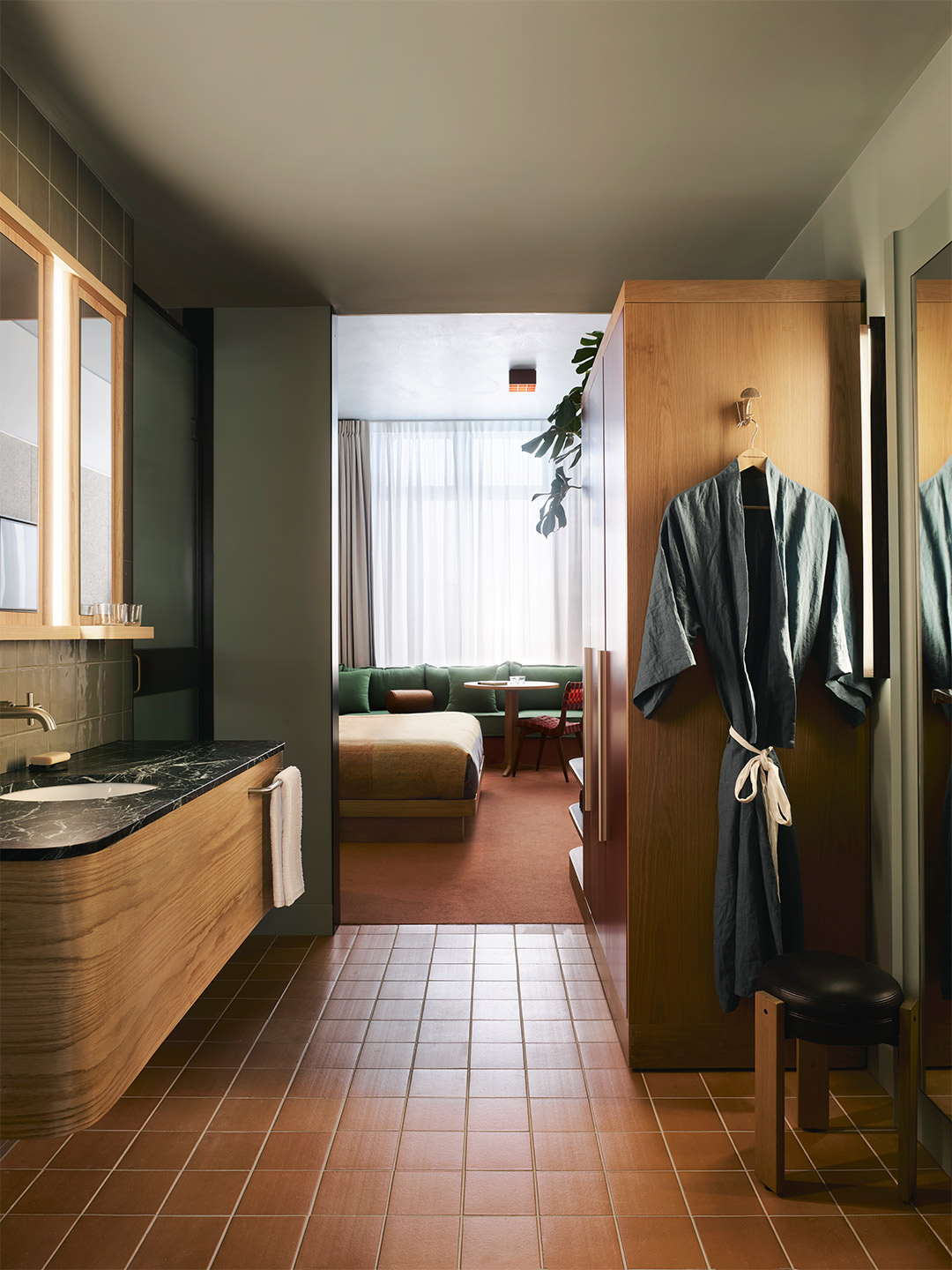
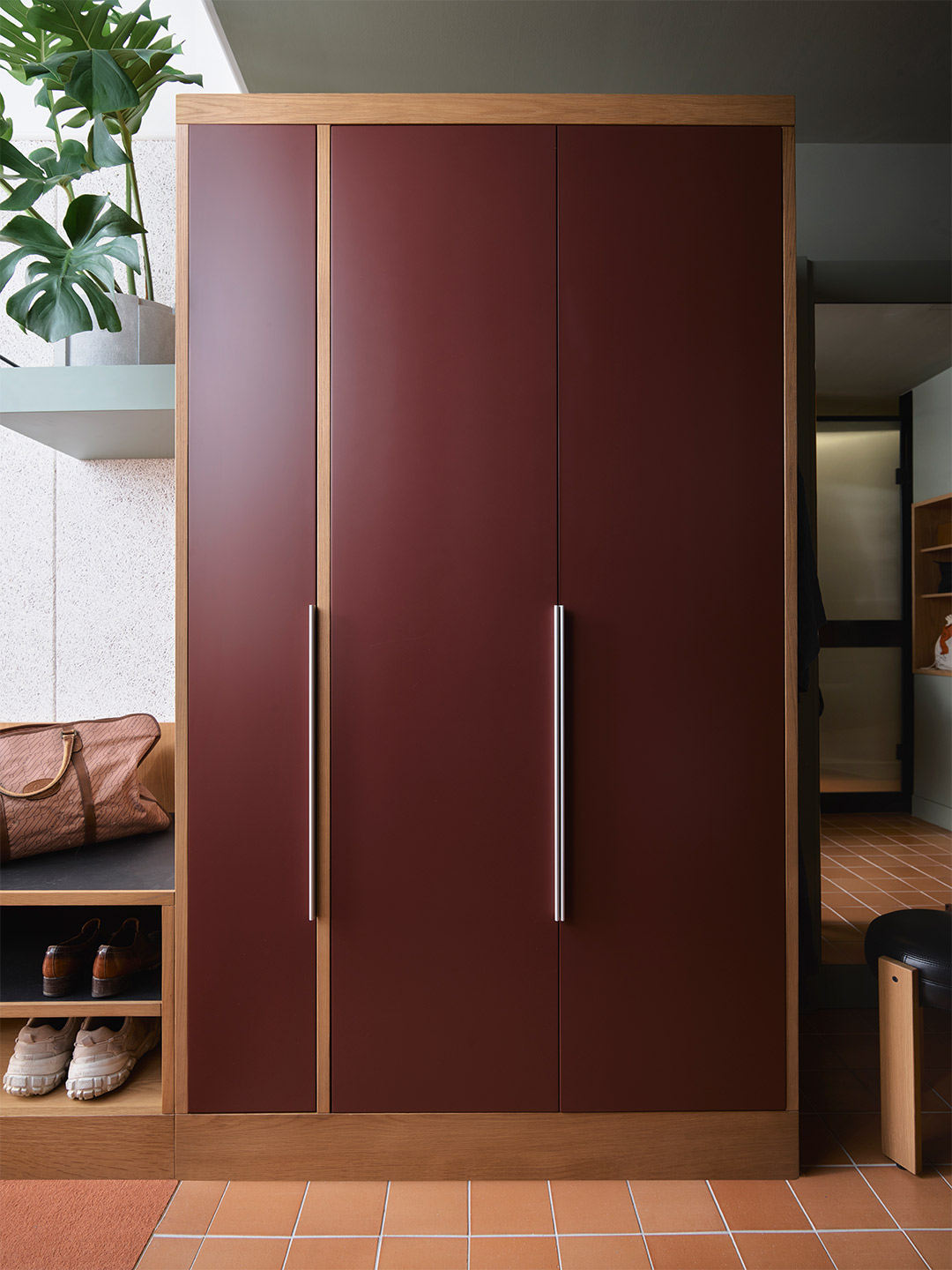

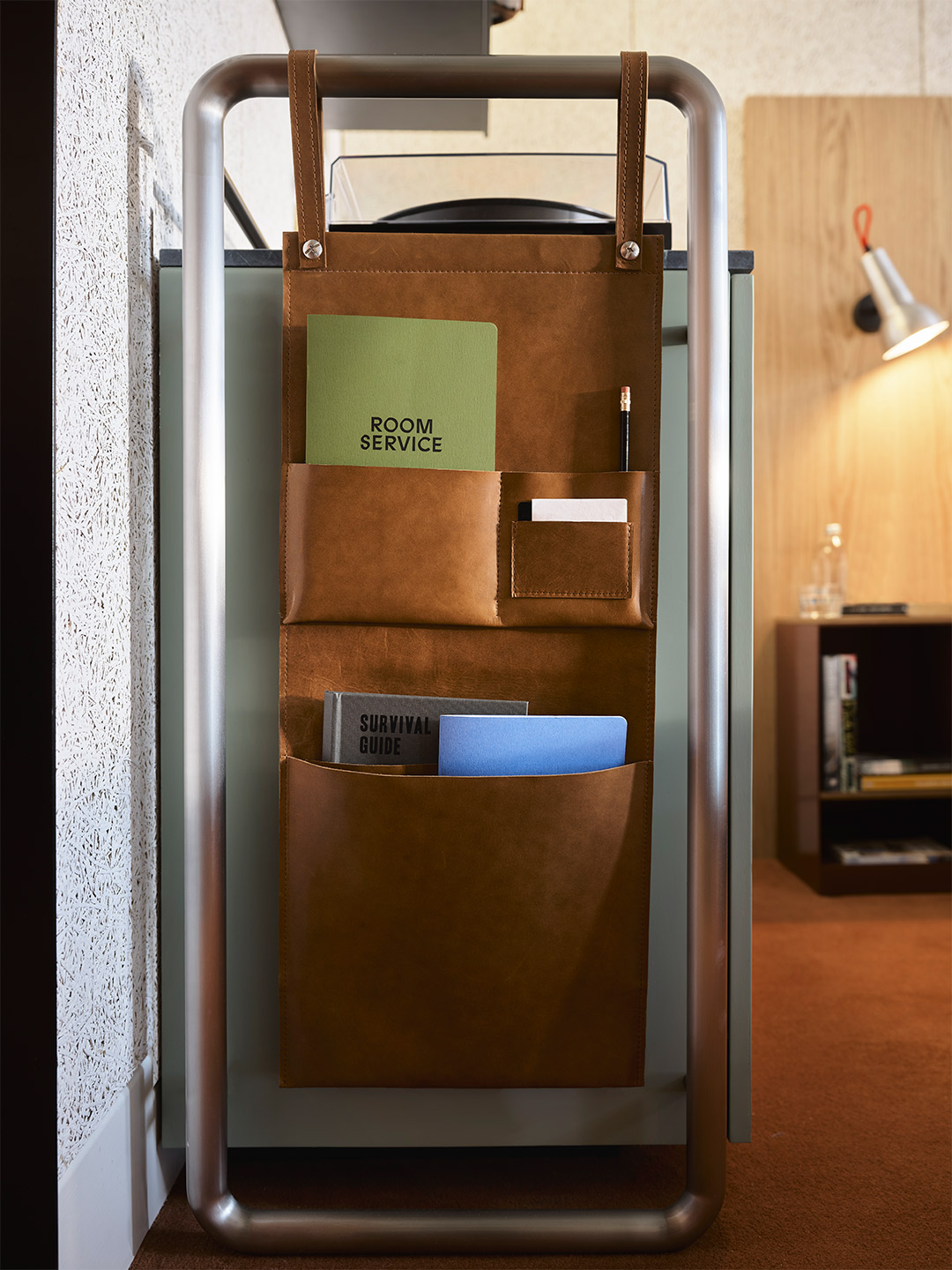
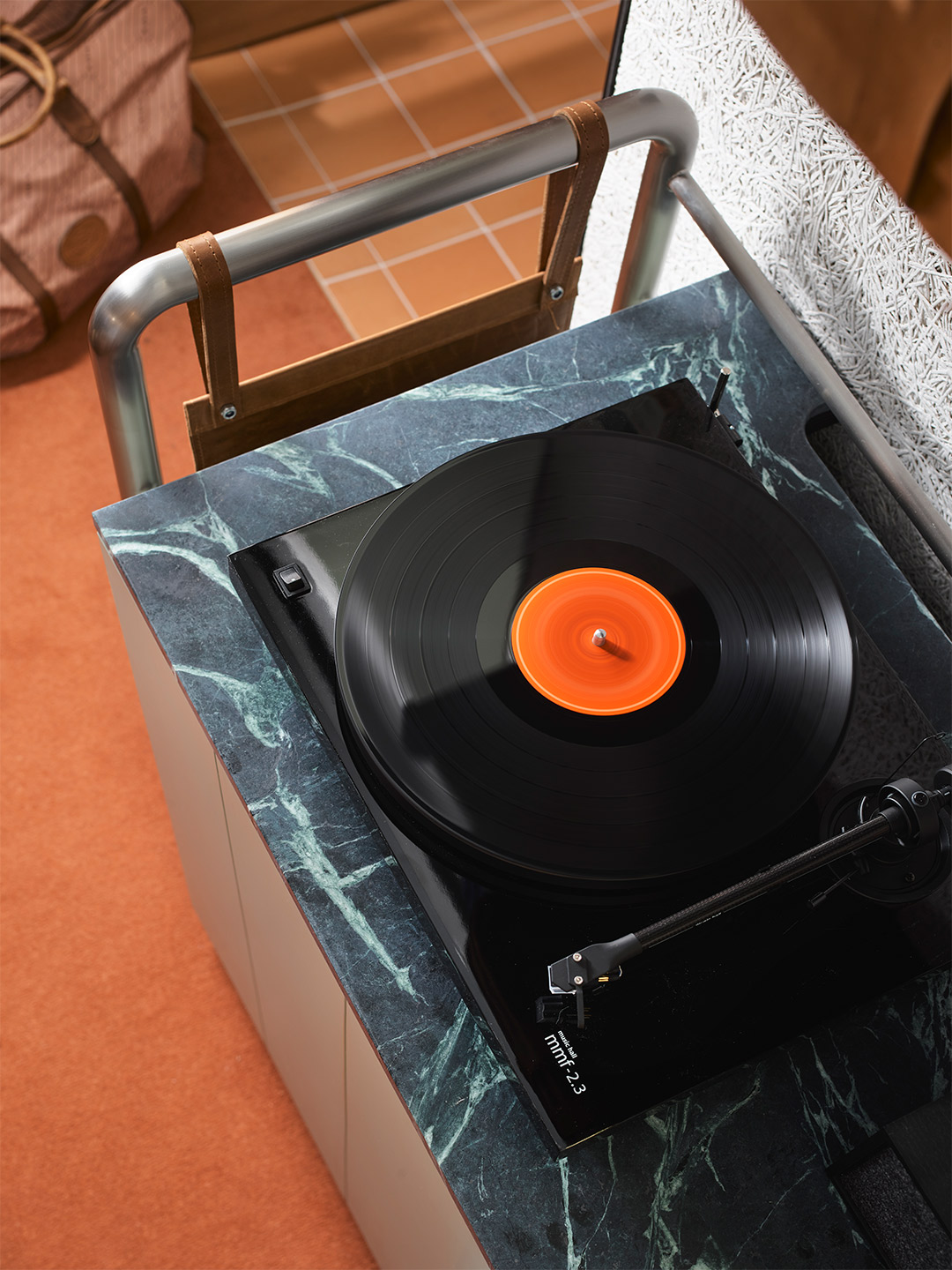
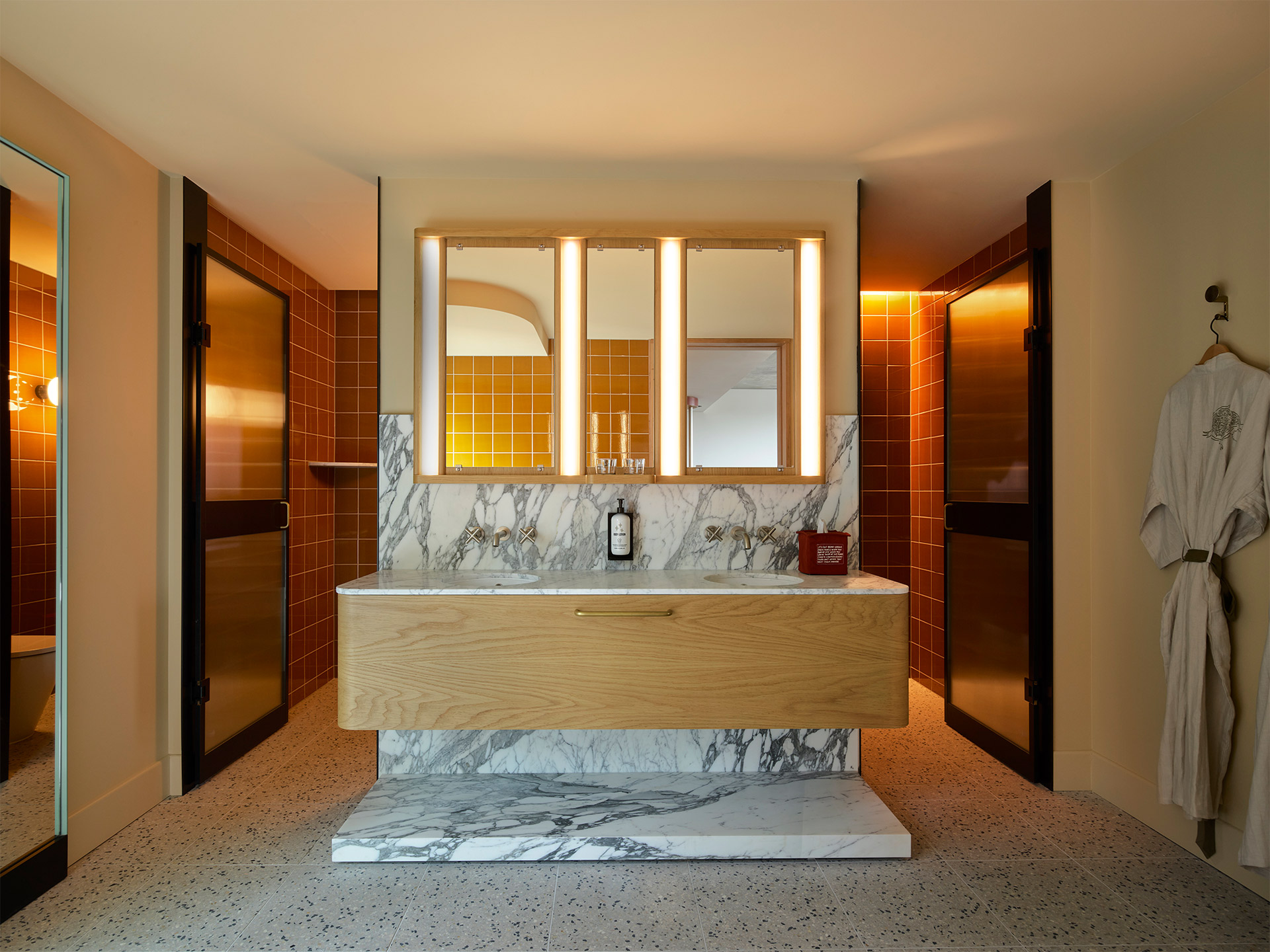
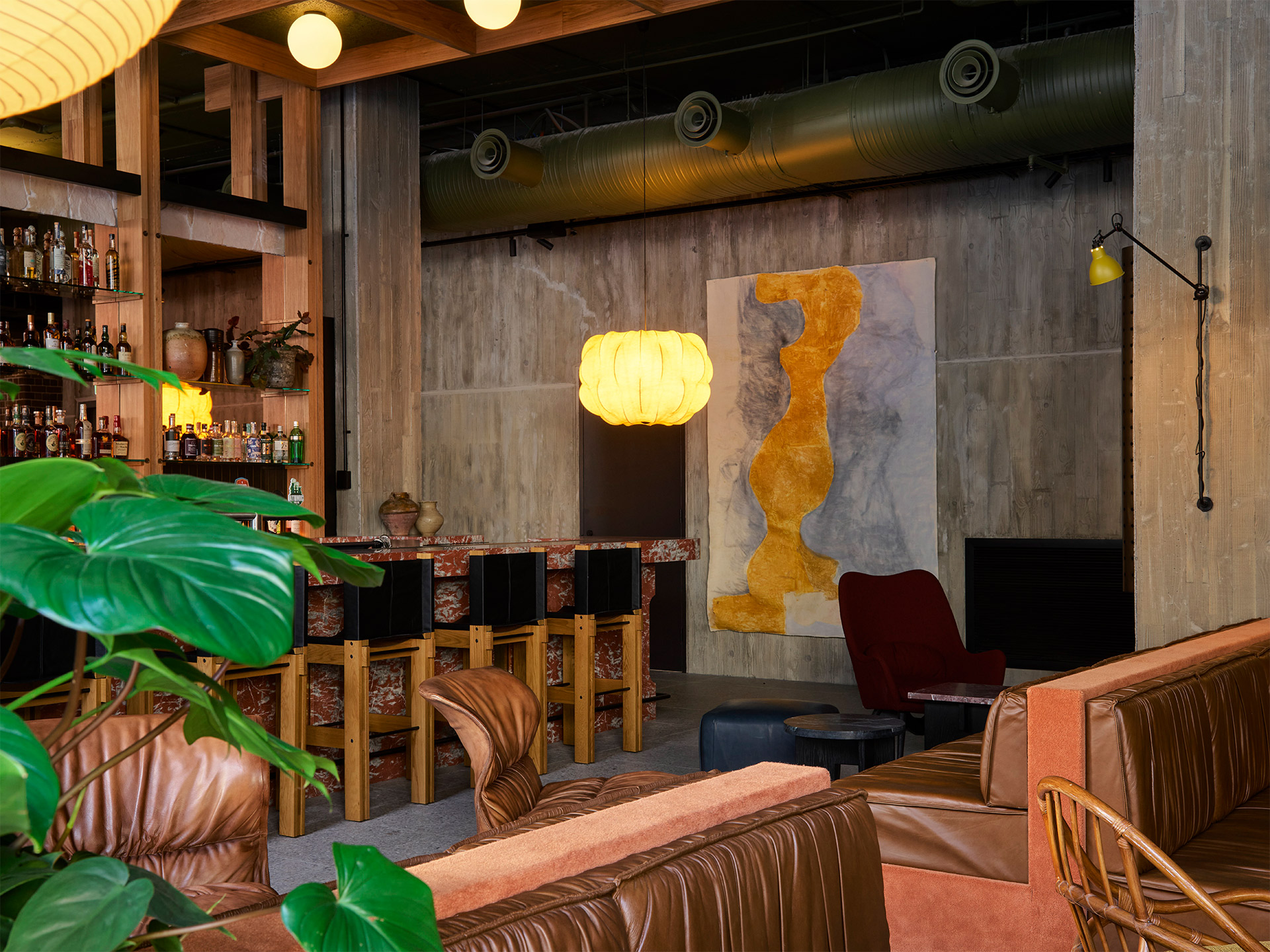
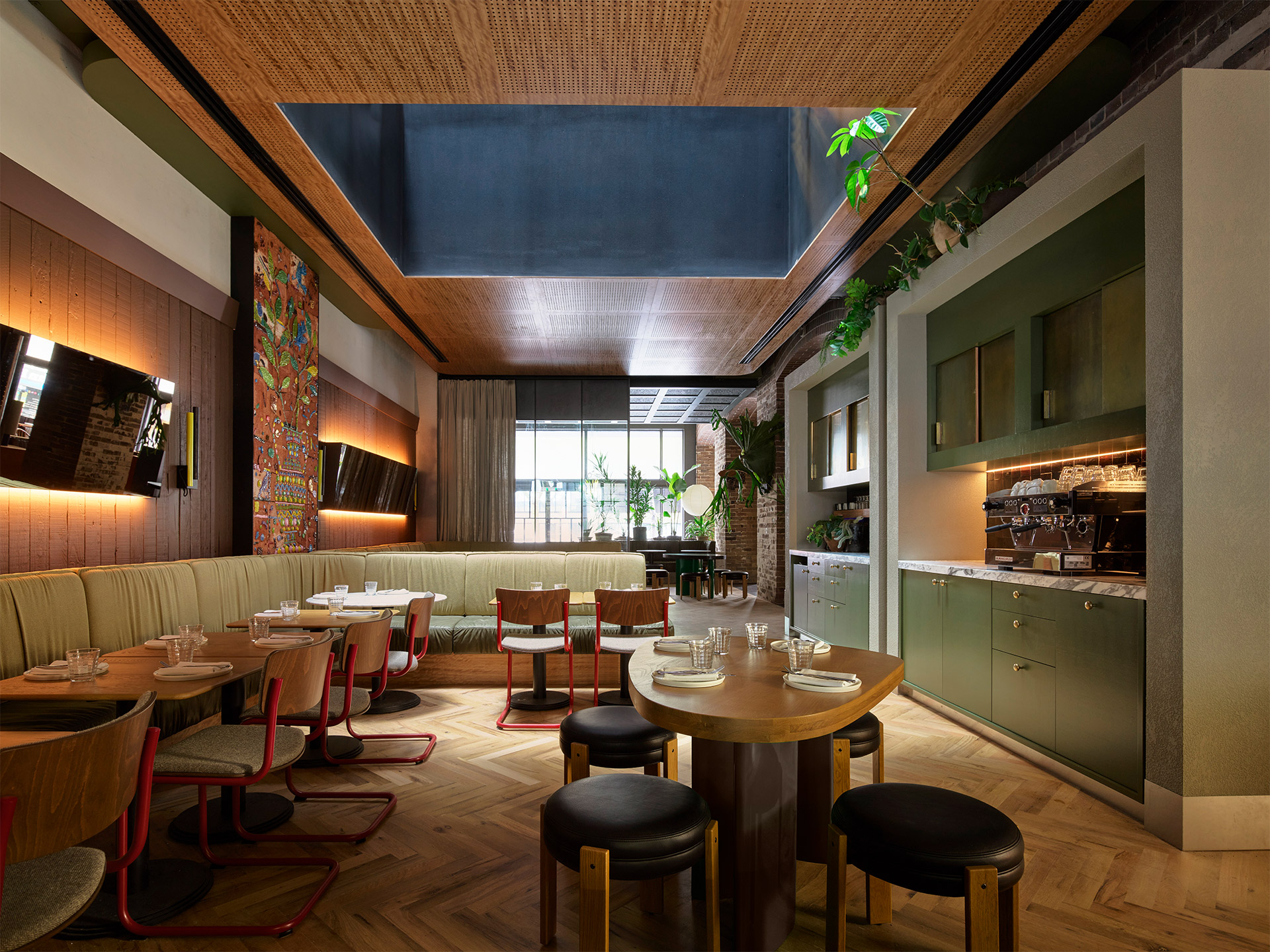
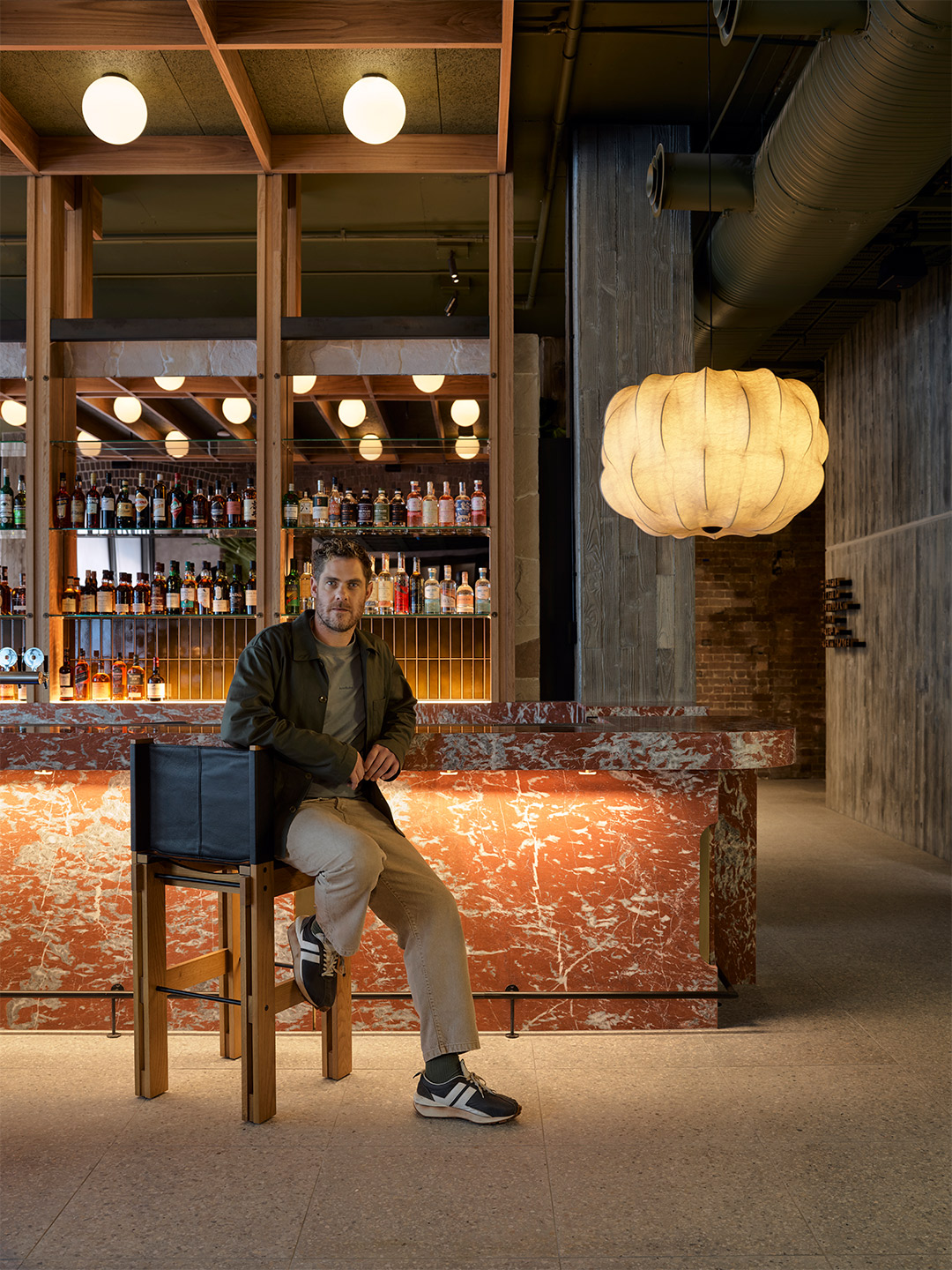
Related stories
- Room service: Inside the Ace Hotel Sydney by Flack Studio.
- The LittleNap ‘luxury hostel’ in Hangzhou by Say Architects.
- Pitch perfect: Utah’s luxury tented pavilions.
- Plesner Architects delivers decadence at the Six Senses Shaharut resort in Israel.
What do destinations such as Kyoto, Seattle, New York and Sydney have in common? Soon enough, they’ll all be home to one of the world’s hippest hotels. The long-awaited Ace Hotel Sydney is poised to swing open its style-studded doors in May of next year, joining a portfolio of ten other boutique hotels, from Palm Springs to Portland, curated specifically for the “people who make cities interesting”.
News of the hotel arrives as many Australians continue to endure lockdowns, while international travel has been a no-go for almost two years. But as the state of New South Wales now moves swiftly to open its borders, and the city of Sydney prepares to once again unfurl its glittering splendours, overseas tourists won’t be the only ones to enjoy a sleepover at the newest Ace. The outpost’s 264 rooms are just as likely to pull a local crowd of design-loving, travel-starved Sydneysiders who are eager to enjoy a staycation in the cultural heart of the city.


Ace Hotel Sydney by Flack Studio
Located in Surry Hills, where money meets a dash of mayhem, Ace Hotel Sydney has hung its hat within the historic Tyne House brick factory – the site of one of Australia’s pioneering ceramic kilns. The project follows the 2020 opening of Asia’s first Ace Hotel, located in Kyoto, the unofficial culture capital of Japan. Featuring interiors by Commune Design, the Japanese outpost resides in a red-brick heritage building from 1926 and a new-build by heavyweight architect Kengo Kuma.
By the time it opens, about two years on from Kyoto, the launch of the Sydney hotel will mark yet another first for Ace – the hospitality group’s debut into the southern hemisphere, made possible through a partnership with Golden Age Group. “We’ve always felt a strong affinity with Australia,” says Brad Wilson, president of the Ace Hotel Group. “Though its culture and character are all its own … its intrepid optimism and renegade spirit resonates with Ace’s roots on the Pacific Coast of America.”
Melbourne-based design outfit Flack Studio, led by founder and director David Flack, was unsurprisingly snagged as the primary design partner for the hotel, forging a creative direction that’s aligned with Ace’s reputation for cultivating cutting-edge experiences. “We love [Australia’s] distinctive brand of modernism, particularly in the use of local organic materials, and were lucky enough to find a perfectly modernist partner in Flack Studio,” Brad says. “David’s eye for colour and space is completely singular – a dream design collaborator for our first hotel in Australia.”

Fuelled by a commitment to creating warm spaces that bring together Australia’s cultural history and Ace’s community-centric approach to hospitality, David says the storied site and its melting pot locale each played a significant role in his studio’s design response. “Surry Hills has been home to so many culturally important movements and people, and has always been a home for creatives and migrating cultures,” he explains. “We wanted to preserve the creative, slightly renegade energy of the space since its origins as one of Australia’s early brickworks.”
Brought to life in the cinematic colours of the Australian landscape, the design of Ace Hotel Sydney superimposes the city’s many eras and evolutions in a contrast of natural textures and tones. Ace’s in-house creative agency, Atelier Ace, explain that Flack Studio cited a number of historical references in this process, including the razor gang wars and underground liquor trade of the 1920s and ’30s, the modernist art boom of the ’60s and the Gay Solidarity Group protests of the ’70s.


“The neighbourhood has long served as home to the most trailblazing and resilient voices of modern Australia – a culture coalesced from Surry Hills’ vibrant migrant communities,” say the Atelier Ace team. “Flack Studio embraced organic materials to create spaces [that are] honest to this history – from the acoustic textural straw walls of the hotel’s guest rooms to the striking ochre red off-form concrete staircase in its lobby.”
As is key at other hotels in the Ace group, an unwavering respect for craftsmanship is woven into the Sydney hotel, with many of the property’s furnishings, artworks and interior flourishes created specifically for the project. The custom furniture, joinery and lighting of the guest rooms was all designed by David and his team, including the textile-adorned window seats that encourage conversation, energised by the eclectic buzz of the streetscape beyond. “Ace Hotel Sydney invites the ready rhythm of Surry Hills inside,” enthuse the Atelier Ace team. “[It will be] an active commons for culture, commerce, art and community.”
Atelier Ace has revealed that Sydney’s Ace Hotel (located at 47-53 Wentworth Avenue, Surry Hills) will also feature a ground-floor restaurant, bar and cafe in the communal lobby, as well as a rooftop restaurant and bar. Would-be guests are invited to make reservations at the hotel from October 1, with rooms available from May 1, 2022.
acehotel.com; flackstudio.com.au
Surry Hills has been home to so many culturally important movements and people, and has always been a home for creatives and migrating cultures.

